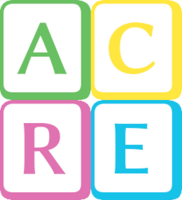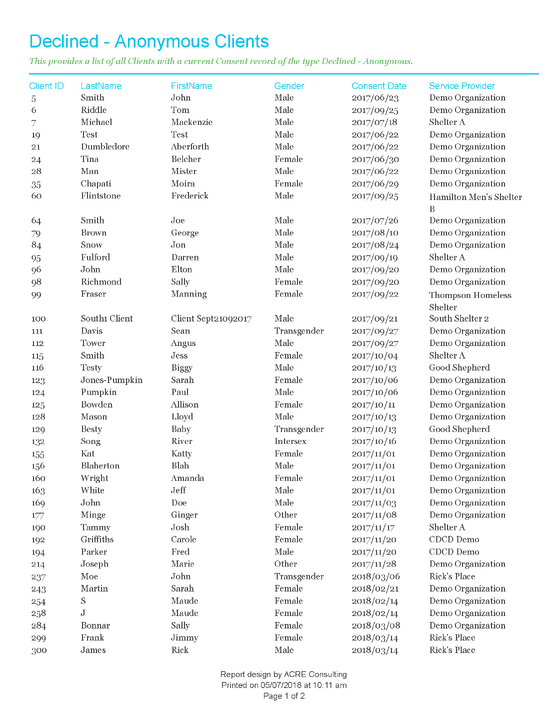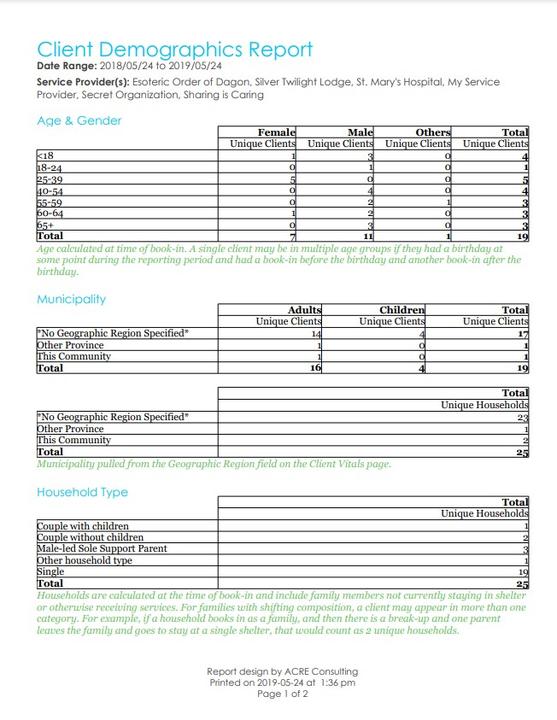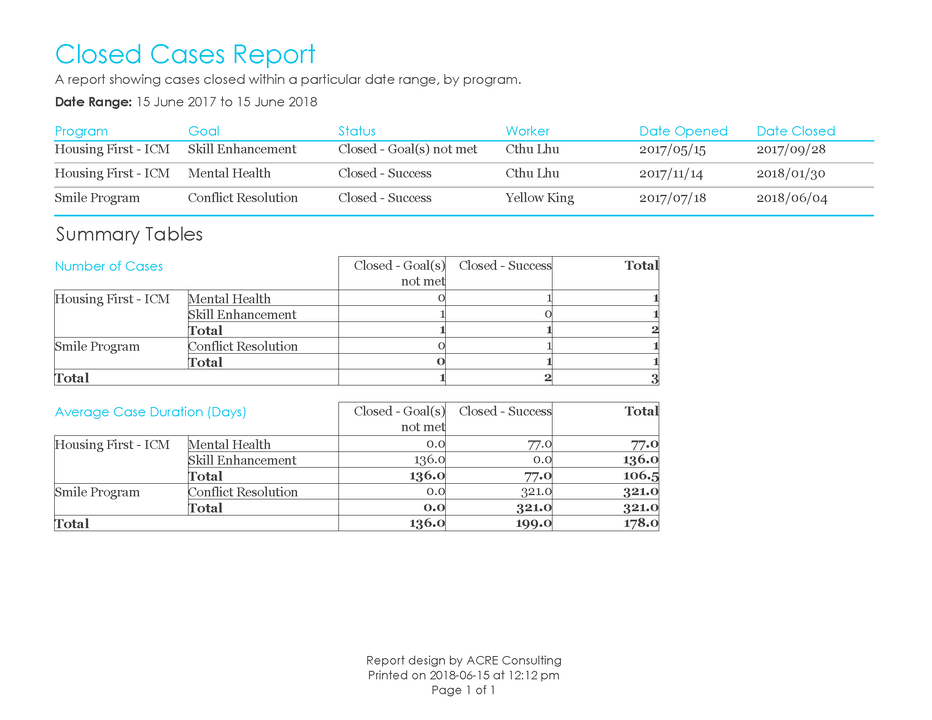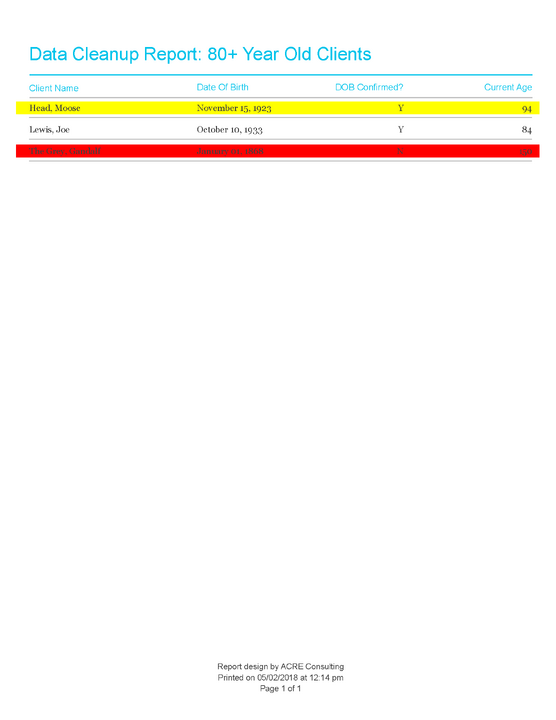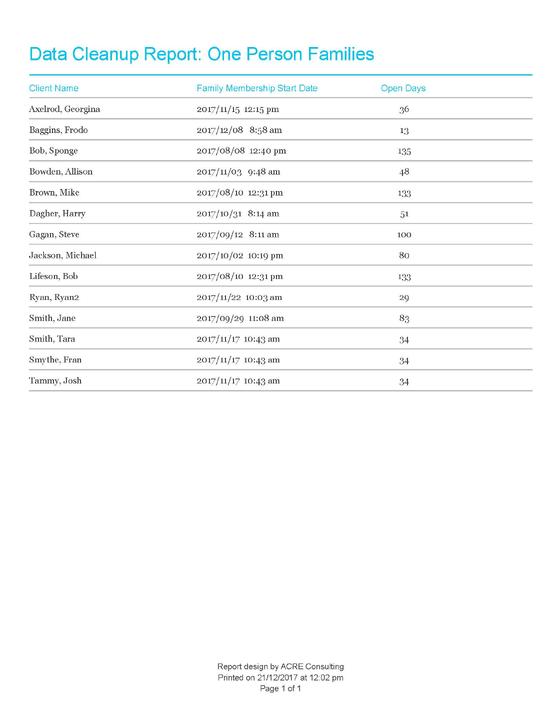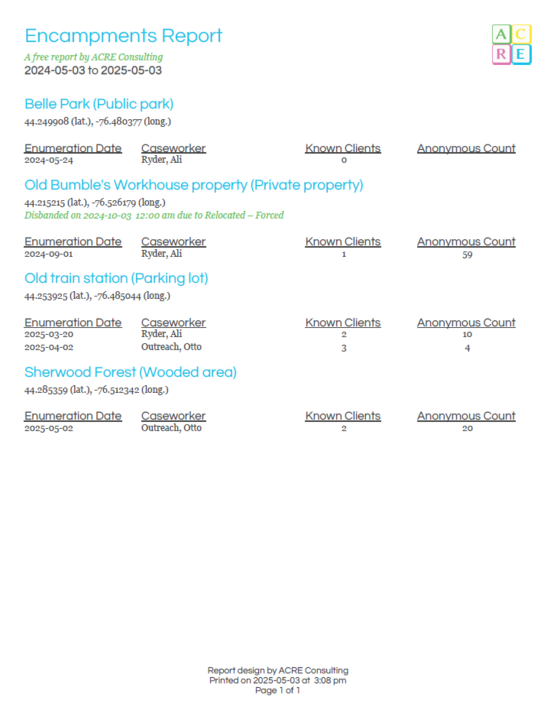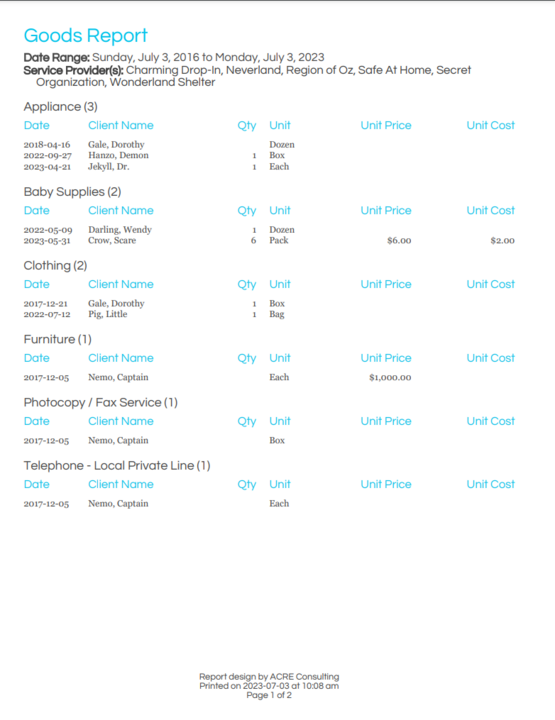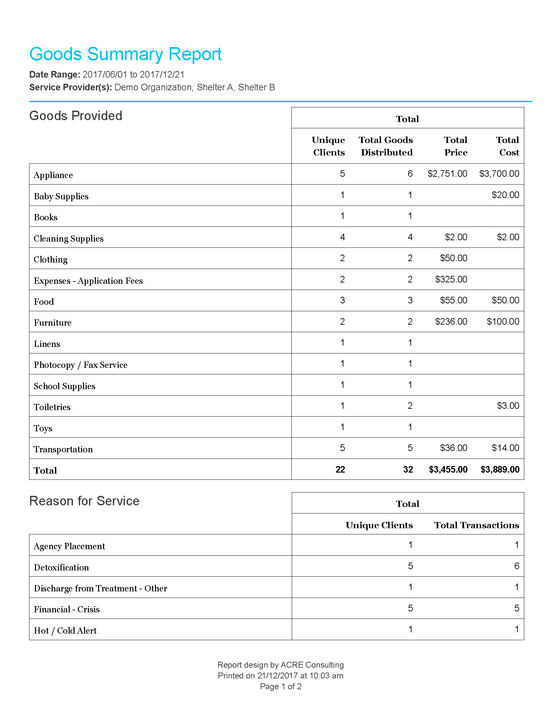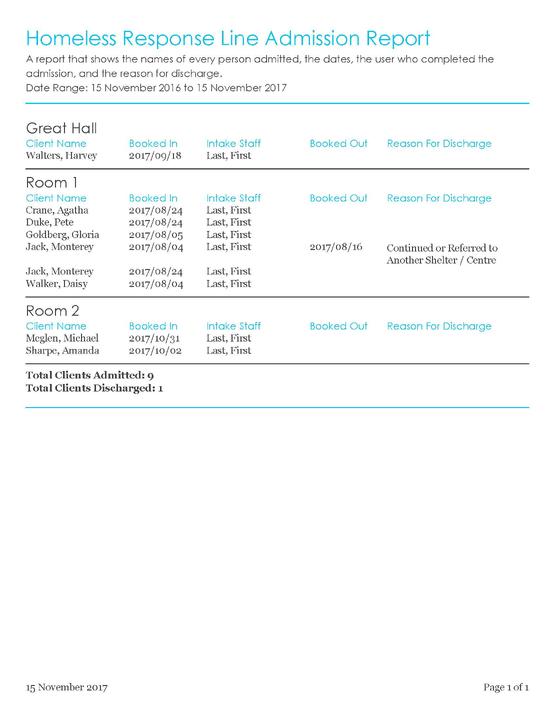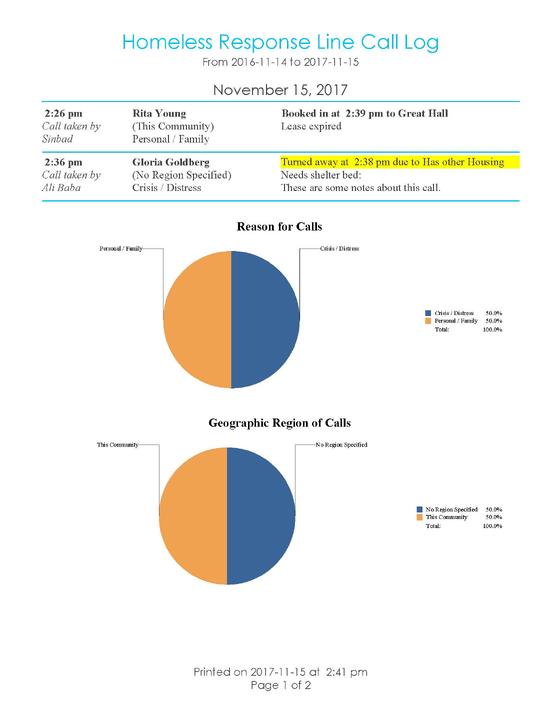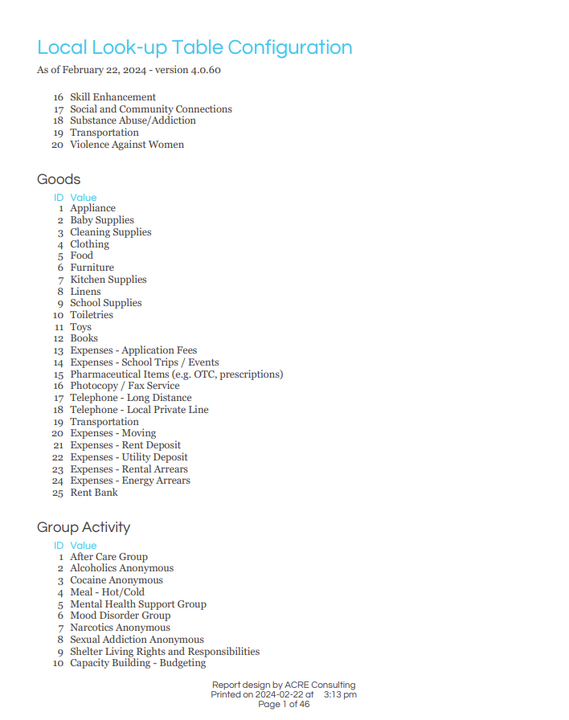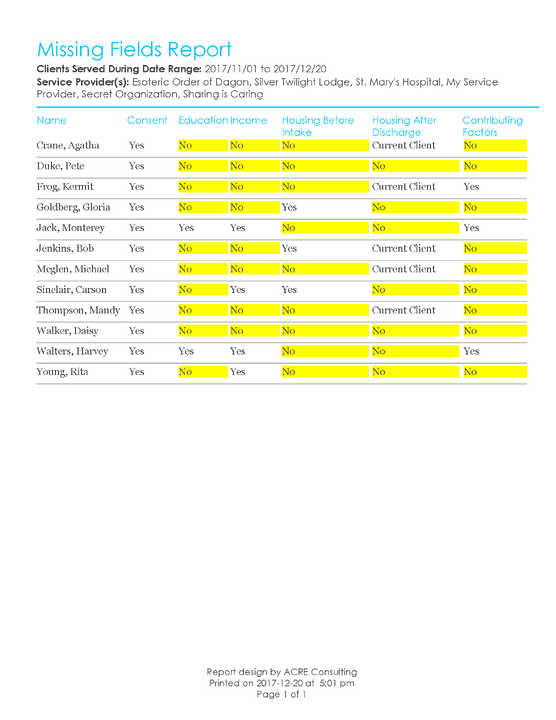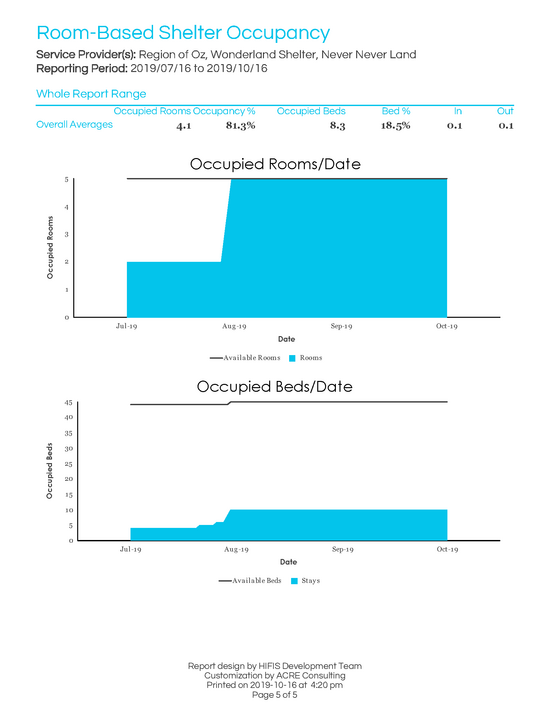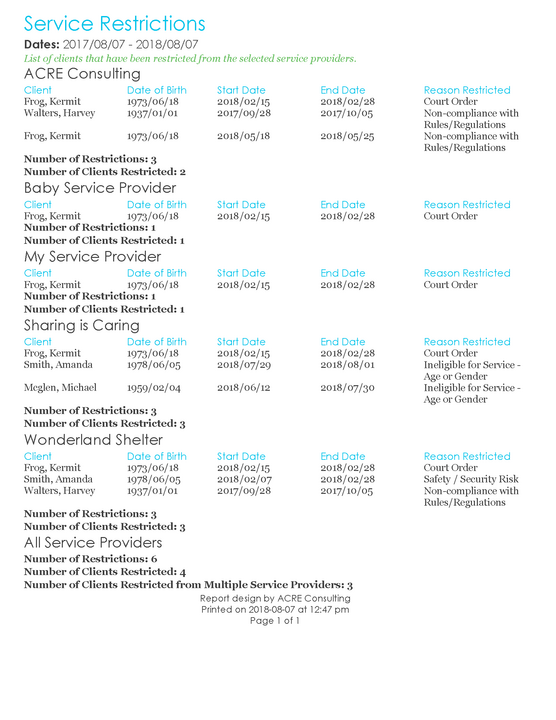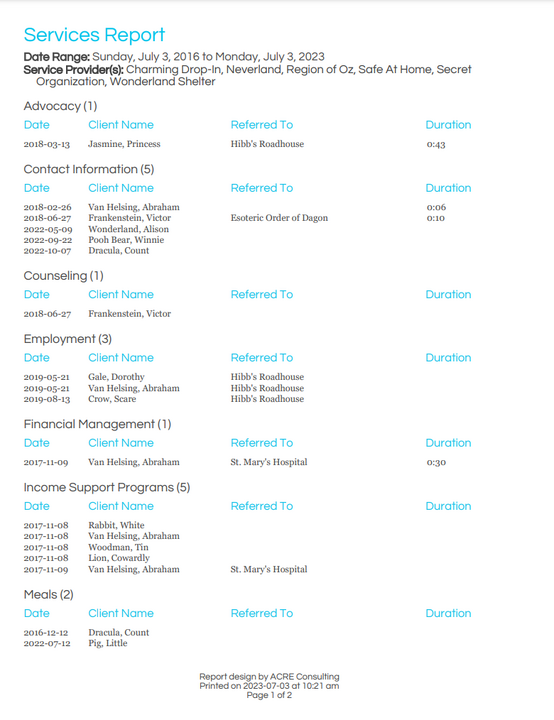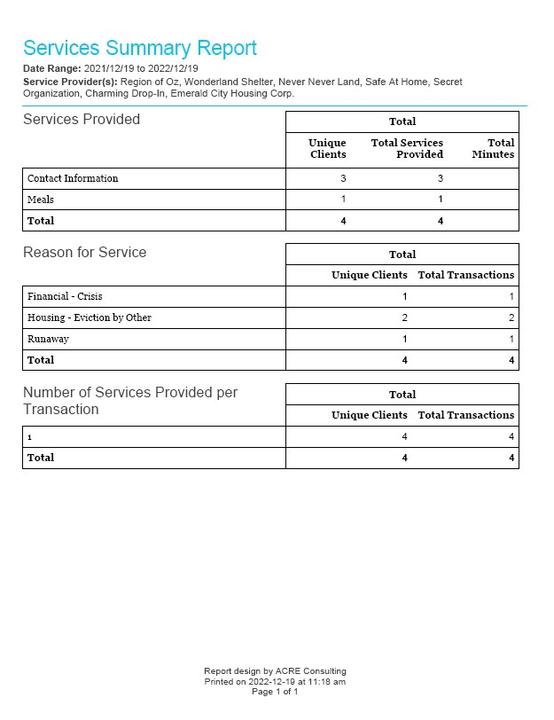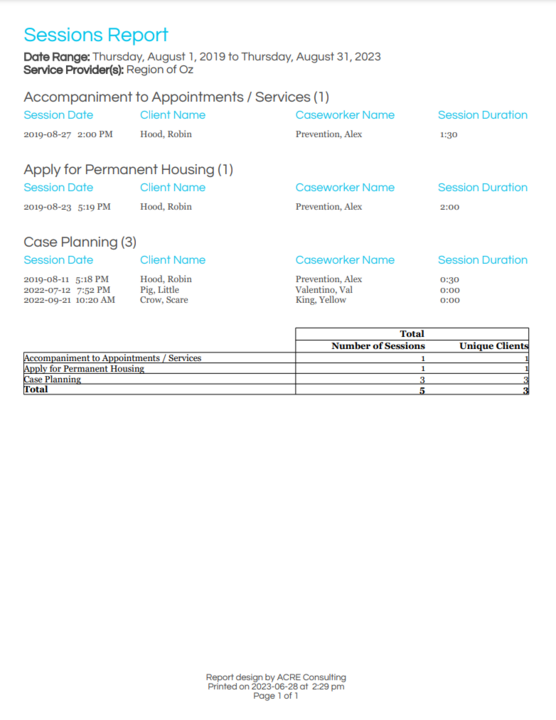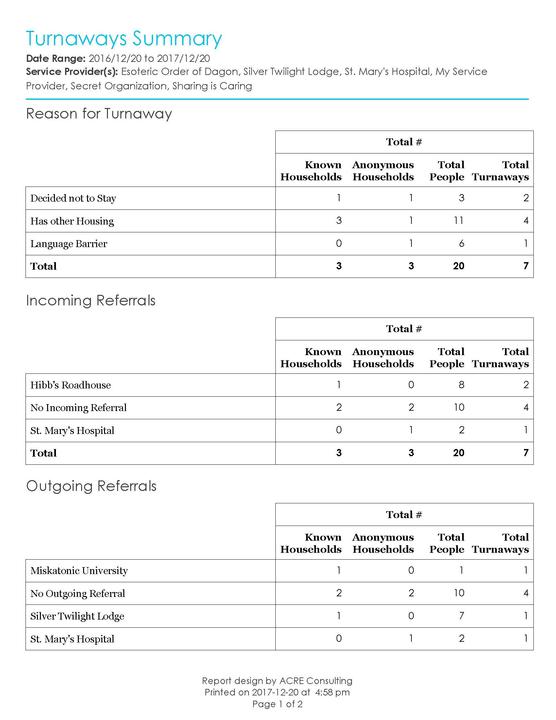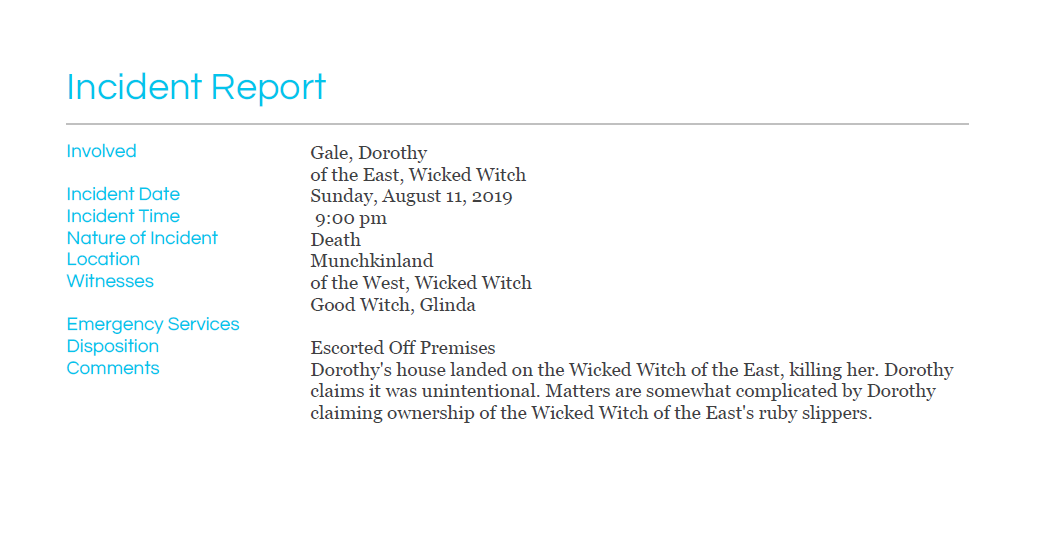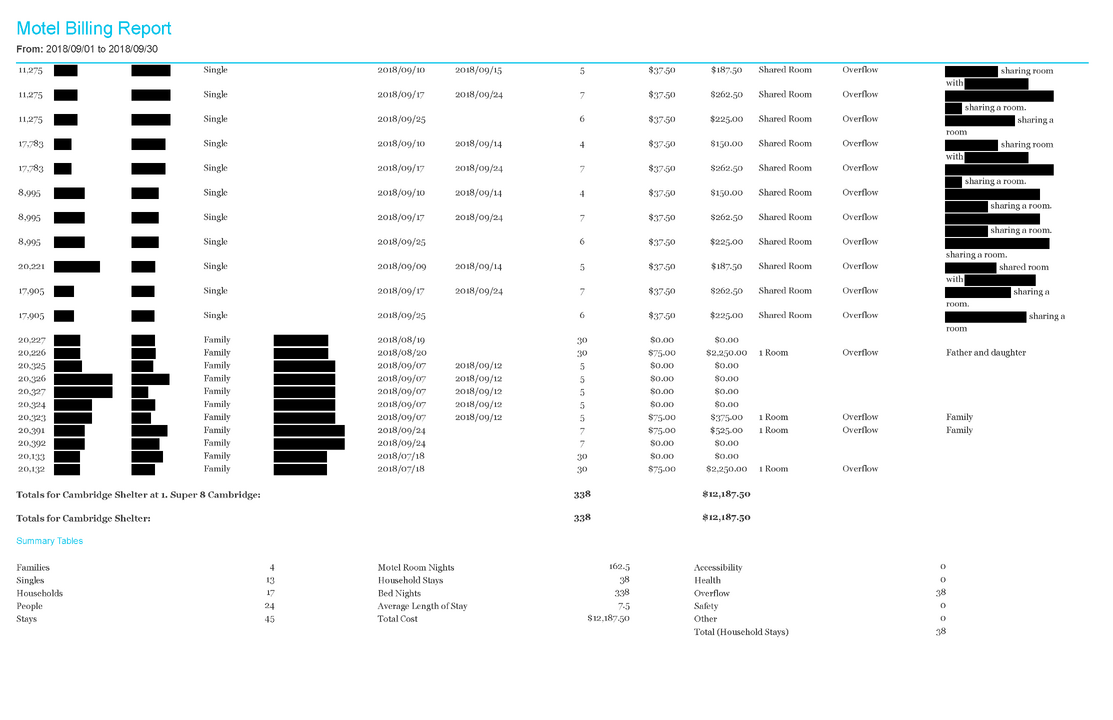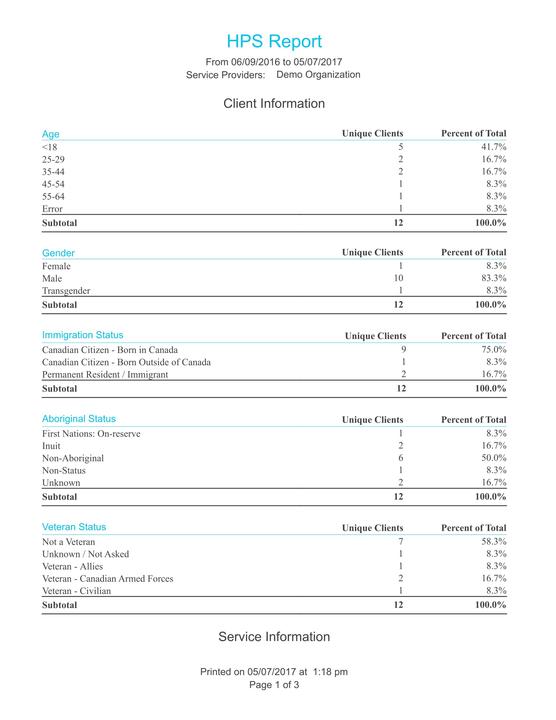Downloadable Reports
Downloadable Crystal Reports for your HIFIS instance

*Presale*
This bundle includes four premium reports focusing on your client subpopulations:
-
Indigenous Clients (coming soon);
-
Refugee Clients; and
Reports can be purchased individually or as a bundle for 40% off regular price!
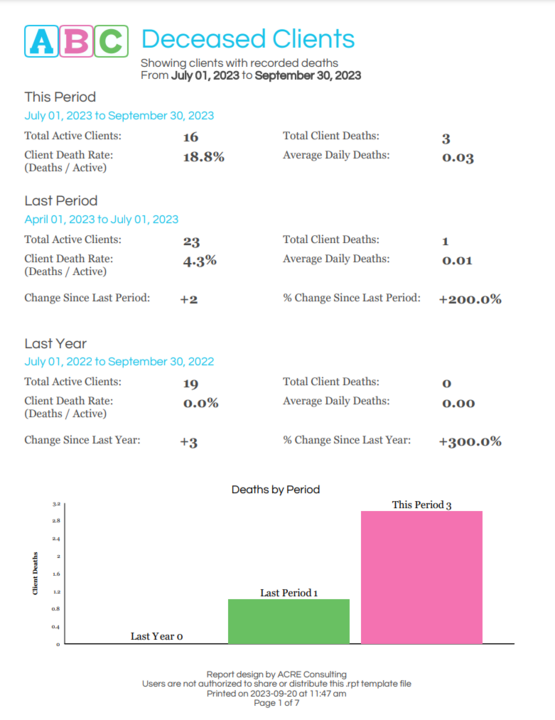
This report contains a summary of relevant information about a client subgroup: deceased clients. For a given date range, it displays how many and which clients died in that period. It also aggregates causes of death, gender, indigenous identity, citizenship and veteran status, and housing status at death. The report shows trends of client deaths over time, contains information about related incident reports, and assists caseworkers to audit their files by indicating which deceased clients still have open files.
This report contains a summary of relevant information about a client subgroup: deceased clients. For a given date range, it displays how many and which clients died in that period. It also aggregates…
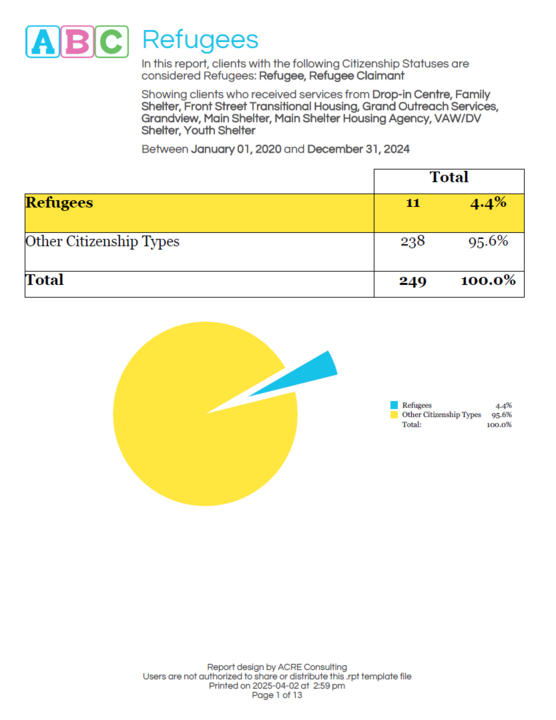
When refugees have nowhere else to go, they end up in emergency homeless shelters. But how many of them are there, and what are their needs? This report contains a breakdown of countries of birth and languages spoken by refugees. It also compares refugees against clients with other citizenship statuses, along the dimensions of: gender, age, housing status, sources of income, identification, contributing factors, and service usage. Finally, it includes a priority list of homeless refugees.
When refugees have nowhere else to go, they end up in emergency homeless shelters. But how many of them are there, and what are their needs? This report contains a breakdown of countries of birth and …
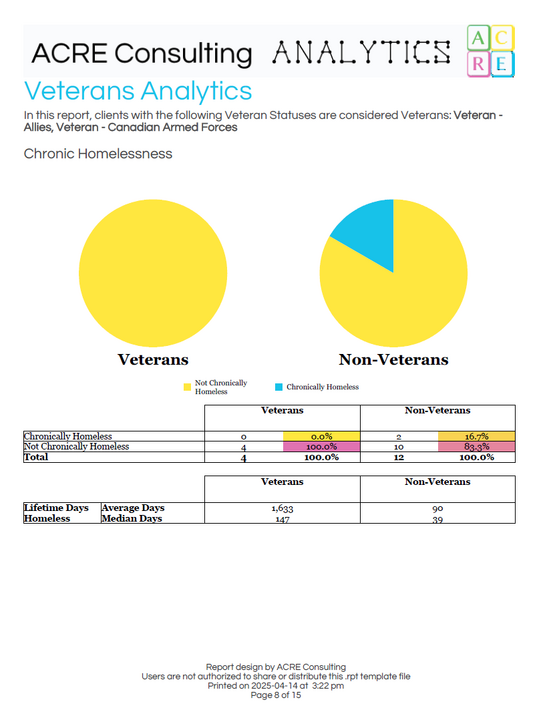
It’s well known that veterans are overrepresented among those who experience homelessness. Resources are available from Veterans Affairs Canada, but sometimes making that connection is difficult. This report contains a breakdown of veterans by veteran status, status verification, and referrals to Veterans Affairs Canada. It also compares veterans against non-veteran clients along the dimensions of: gender, age, housing status, chronic homelessness, sources of income, identification, contributing factors, and service usage. Finally, it includes a priority list of homeless veterans.
It’s well known that veterans are overrepresented among those who experience homelessness. Resources are available from Veterans Affairs Canada, but sometimes making that connection is difficult. This…

Get those client files in good shape! This bundle includes four premium reports focusing on the completeness of your Client Information:
- Client Vitals Completeness;
- Client Information Completeness;
- Housing History Completeness 1; and
- Housing History Completeness 2.
Reports can be purchased individually or as a bundle for 40% off regular price!
Get those client files in good shape! This bundle includes four premium reports focusing on the completeness of your Client Information:
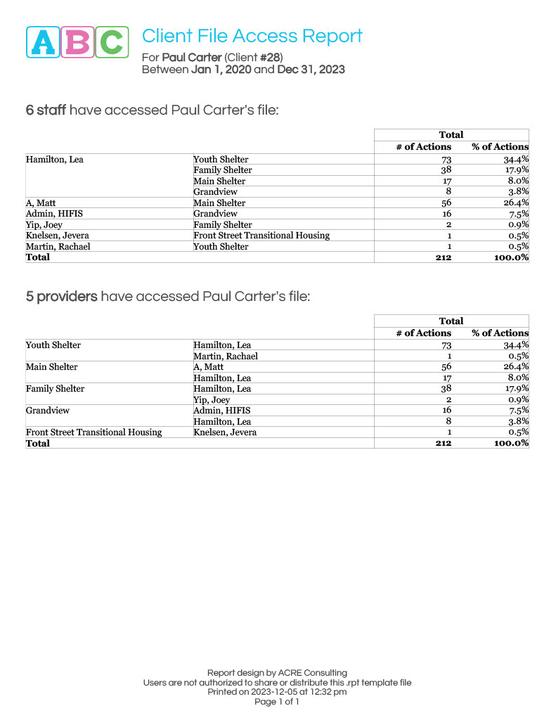
Ever had a need to see who had accessed a particular client file? Sure, you can use the Audit Log, but it's not exactly convenient. This report summarizes in one easy-to-read page which users and which service providers have interacted with a given client file within a specified period of time.
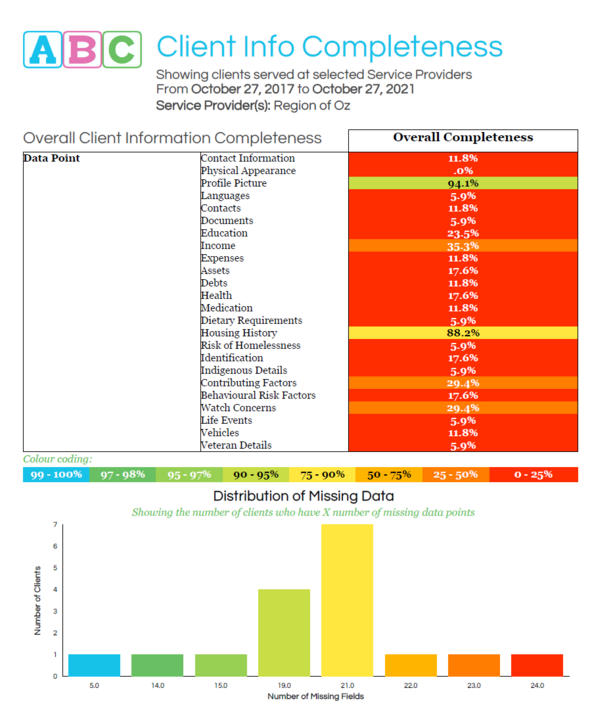
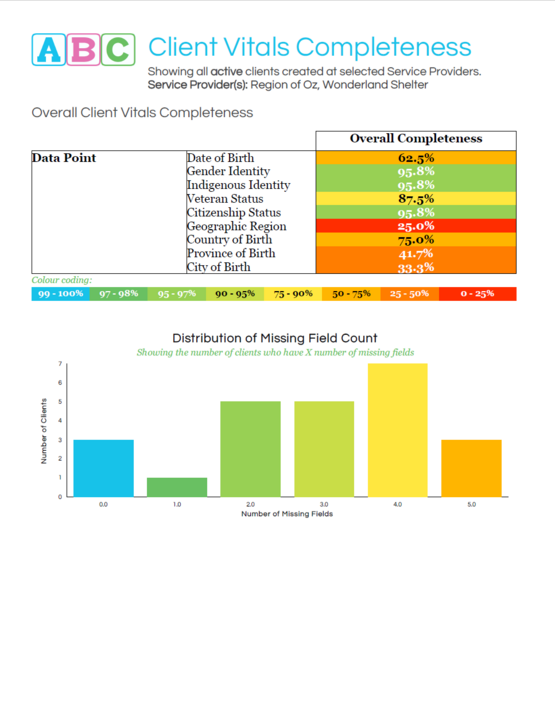

Work out those duplication issues! This bundle includes 2 reports that together can help you tackle the problem of duplicated client files in HIFIS:
Reports can be purchased individually or as a bundle for 20% off regular price!
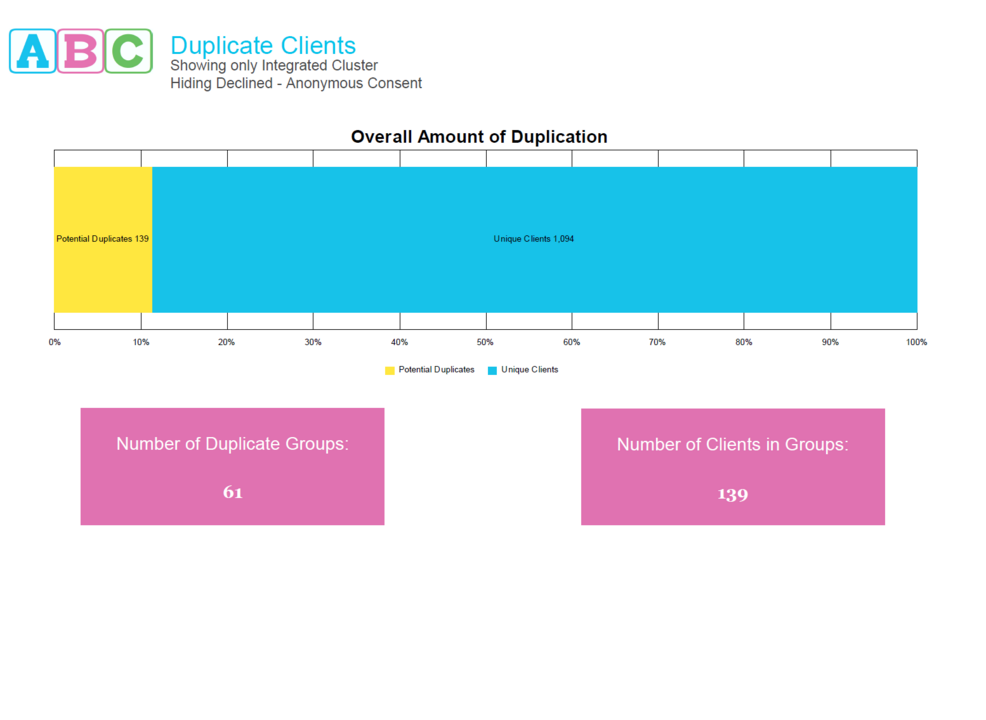
Hunt down those duplicate clients! This report uses advanced methods to identify potential duplicates, helping you identify duplicate clients with misspelled names, swapped middle-first names, and even matching aliases. You get to choose whether to include clients with Declined - Anonymous consent, and whether you want to expand your search to other Clusters. Improve your database's uniqueness today!
Hunt down those duplicate clients! This report uses advanced methods to identify potential duplicates, helping you identify duplicate clients with misspelled names, swapped middle-first names, and eve…
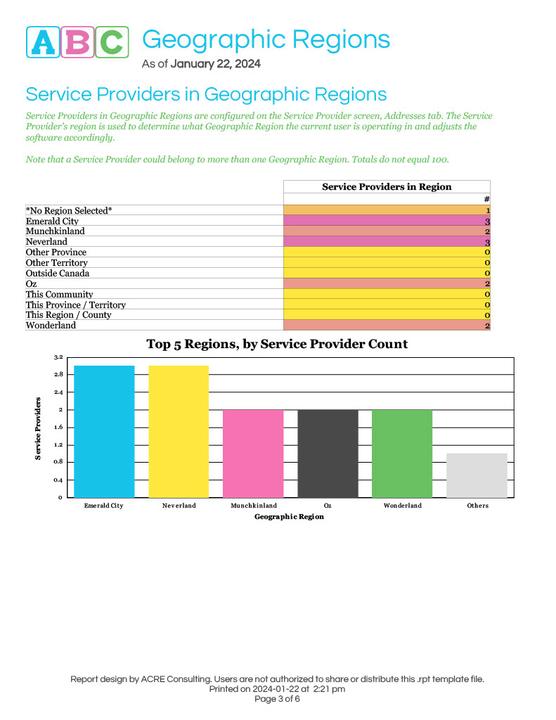
Are you using the Geographic Region Filter? It’s a useful tool, but can be a little fiddly sometimes. Here’s a report that can help you review your Geographic Region settings. Tidying everything up will result in a cleaner user experience for your staff and cleaner data for you.
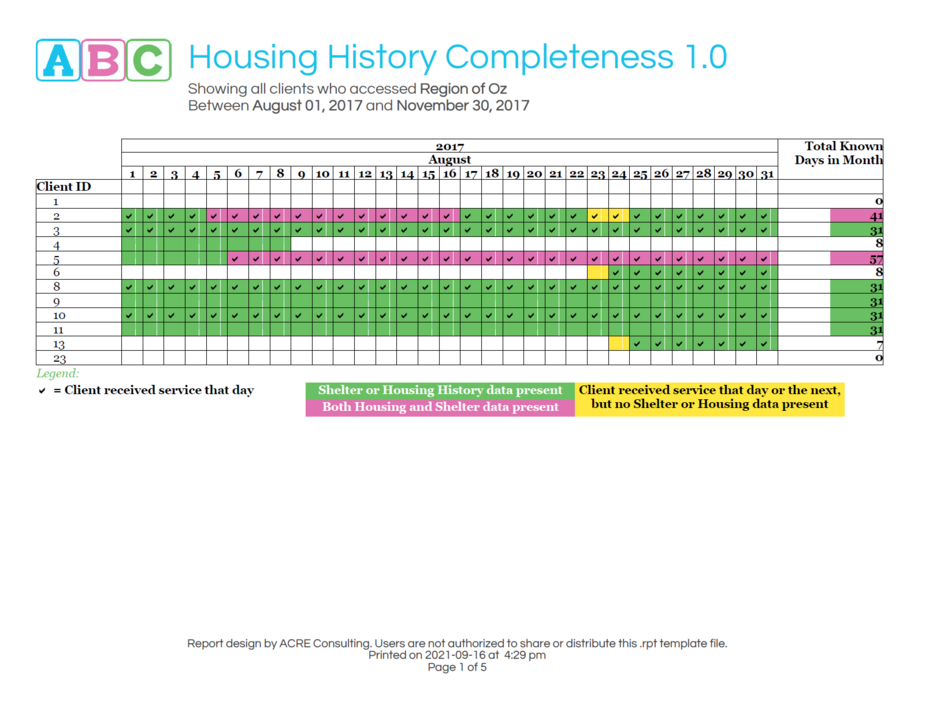
This report contains a visual representation of the dates for which Housing History (or Admissions) data is present or absent for each recently assisted client. The report prompts for a single service provider and a date range, and every client that received services of any sort from that service provider in the date range are listed, along with every date in the range.
This report contains a visual representation of the dates for which Housing History (or Admissions) data is present or absent for each recently assisted client. The report prompts for a single service…
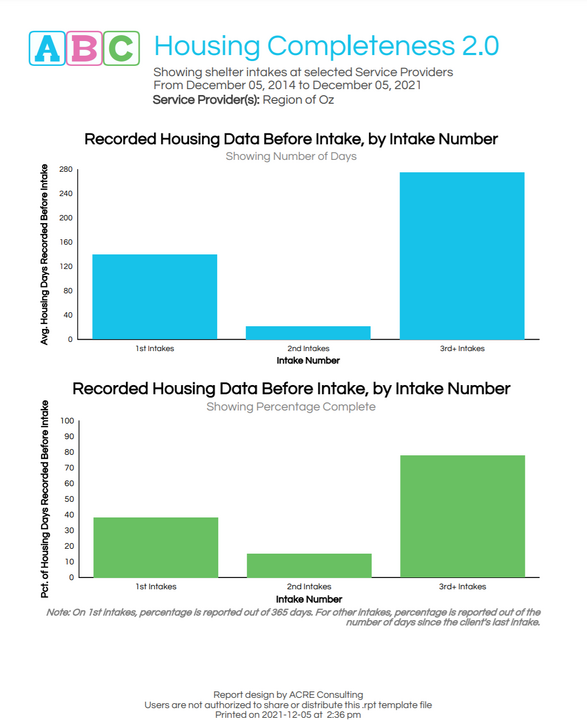
This 13+ page report displays useful aggregated data about how well or poorly specific shelter service providers and users are performing at collecting prior housing history data when clients present for shelter. The report prompts for a date range and service providers, and calculates how much is known about the client's residential situation since their last shelter stay.
This 13+ page report displays useful aggregated data about how well or poorly specific shelter service providers and users are performing at collecting prior housing history data when clients present …
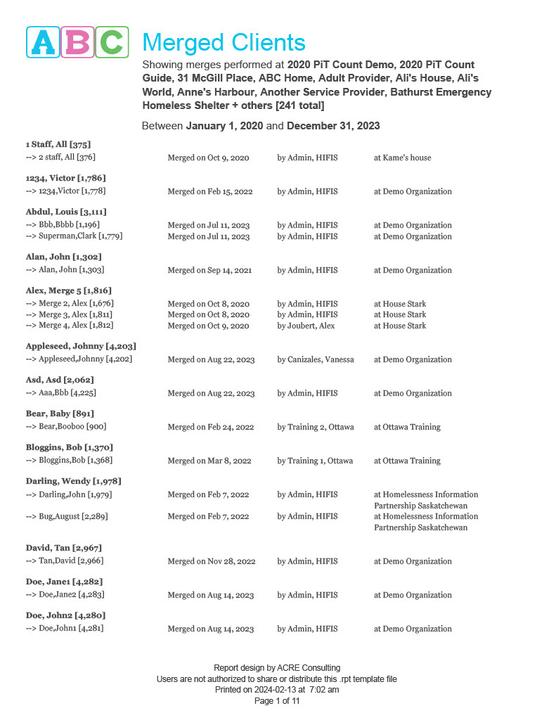
Do you suspect that a client disappeared because they were merged? Wonder how frequently your super users are actually using the merge function? If you want to get a better handle on how clients are being merged in your community, this is the report for you! With two different output options, you can choose to either look for a specific client, or review multiple merges that took place in your community.
Do you suspect that a client disappeared because they were merged? Wonder how frequently your super users are actually using the merge function? If you want to get a better handle on how clients are b…

Wondering whether your staff are actually using the modules you've provided them with access to? This is the report for you.
This report shows aggregated usage patterns for users at selected Service Providers in a selected date range. It looks at data about the frequency of record creation in the Client Management modules (e.g. Admissions, Case Management, Incidents, etc.). The report displays average record creation frequency per user, broken down by Service Provider and Rights Template.
Wondering whether your staff are actually using the modules you've provided them with access to? This is the report for you.
This report shows aggregated usage patterns for users at selected Service …
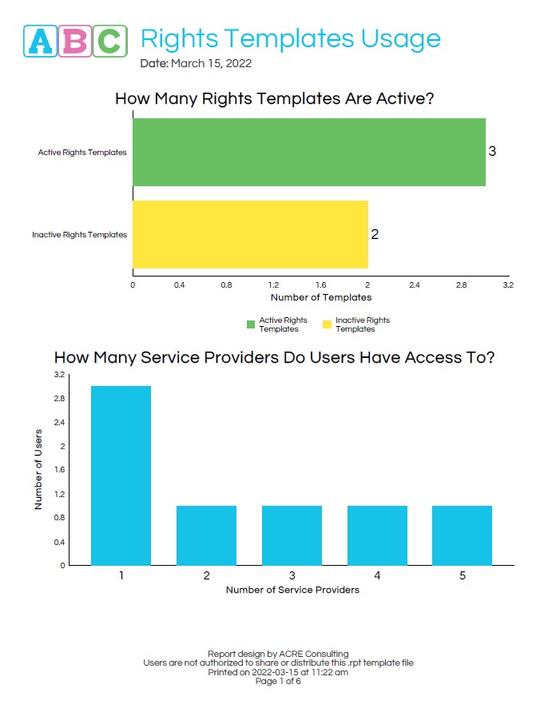
It can be HARD to keep your users, service providers, and rights templates straight. Who has which template? Which users have access to what service providers? This report is designed to help you answer these questions and manage that aspect of your system.
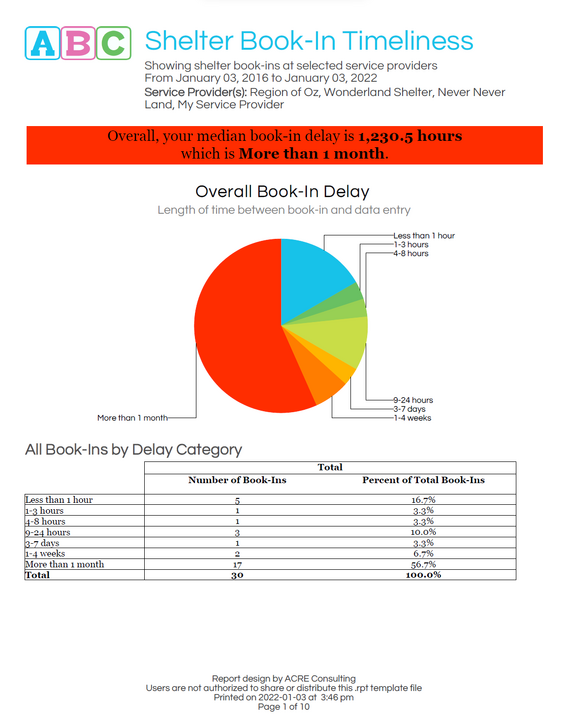
This report contains everything a community or service provider needs to conduct a data quality timeliness audit for their shelter book-ins. It measures the gap between actual book-in time and data entry time.

This report contains everything a community or service provider needs to conduct a data quality timeliness audit for their shelter book-outs. It measures the gap between actual book-out time and data entry time.
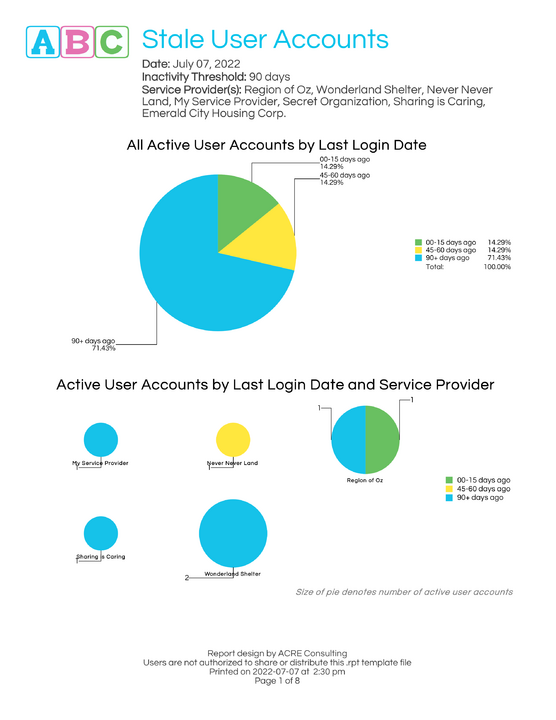
This report identifies stale user accounts, covering: users who haven't agreed to the EULA, users who have never logged in, users with no logins in a timeframe you specify, users with concurrent logins, infrequently used accounts, median days since most recent login, and average logins per user.
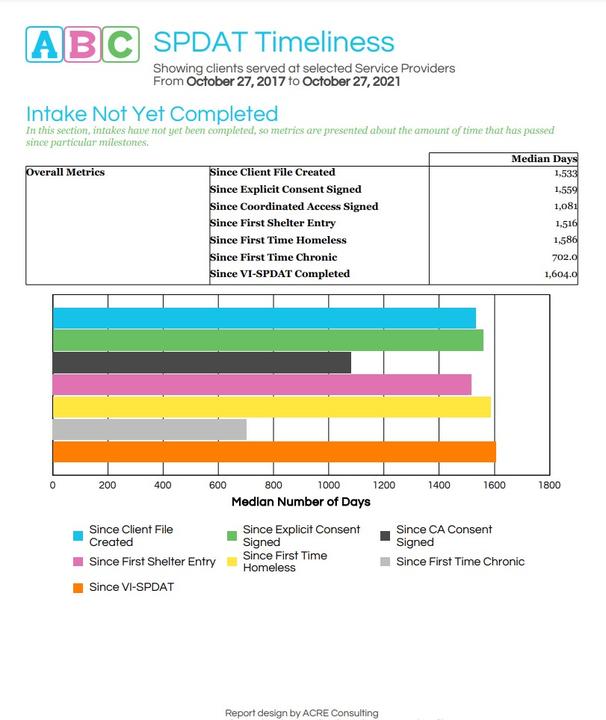
This 21+ page report helps communities to assess whether clients are being assessed on time. It measures when the SPDAT was completed for clients, relative to the milestones of: client file creation, providing explicit and CA consent, first shelter book-in, first VI-SPDAT, and first becoming homeless and chronically homeless. The report shows clients served by specific service providers within a specific date range.
This 21+ page report helps communities to assess whether clients are being assessed on time. It measures when the SPDAT was completed for clients, relative to the milestones of: client file creation, …

This report is used to monitor when users are accessing client files that they shouldn't be. It's not possible to prevent such access, so the best thing we can do is to provide useful tools to audit and monitor user access. It shows instances where a User with a Conflict against a Client accesses that Client's file or data during the period that the Conflict was active, as described in this blog post.
This report is used to monitor when users are accessing client files that they shouldn't be. It's not possible to prevent such access, so the best thing we can do is to provide useful tools to audit a…
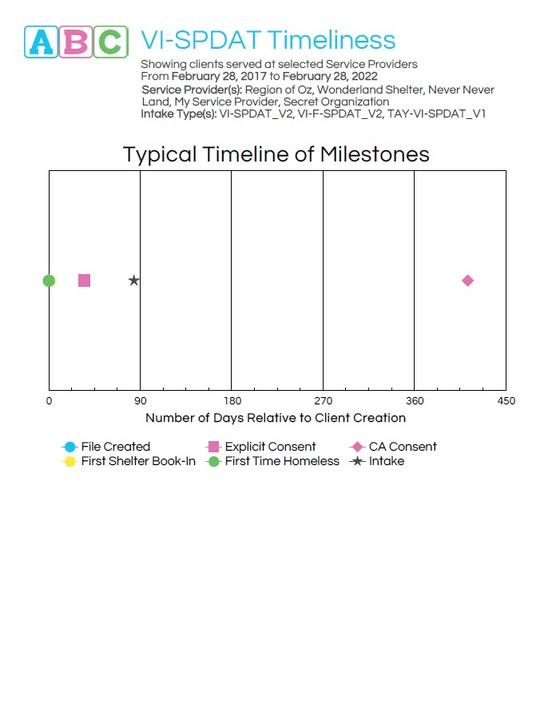
This 18+ page report helps communities to assess whether clients are being assessed on time. It measures when the VI-SPDAT was completed for clients, relative to the milestones of: client file creation, providing explicit consent, providing coordinated access consent, first shelter book-in, and first becoming homeless. The report shows clients served by specific service providers within a specific date range.
This 18+ page report helps communities to assess whether clients are being assessed on time. It measures when the VI-SPDAT was completed for clients, relative to the milestones of: client file creatio…

This report was created by ACRE Consulting to help communities understand the scope of their homeless population, in real time. This report measures the following three indicators:how many clients have active and valid consenthow many clients are actively receiving serviceshow many clients are known to be homeless A combination of these three measures can be used to determine how many people are known to be active...
This report was created by ACRE Consulting to help communities understand the scope of their homeless population, in real time. This report measures the following three indicators:how many clients hav…
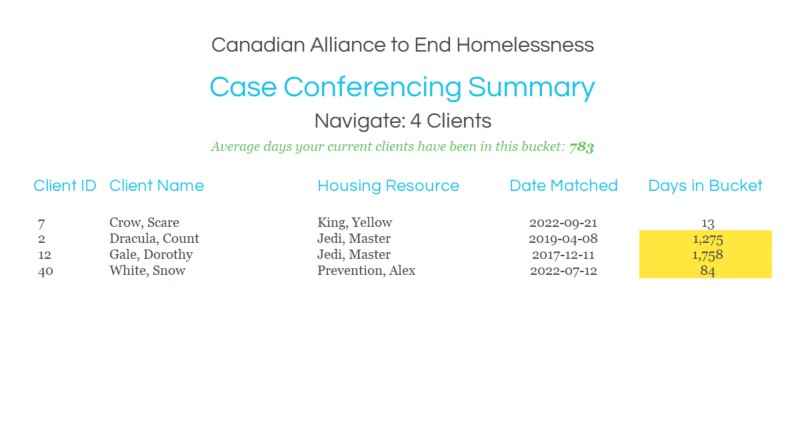
This report is designed to help communities with their Action-Oriented Case Conferencing by dividing their actively homeless clients into three buckets: Assess, Match, and Navigate. For each bucket, clients are listed, along with the date they were added to the bucket and how long they've been in the bucket.
This report is designed to help communities with their Action-Oriented Case Conferencing by dividing their actively homeless clients into three buckets: Assess, Match, and Navigate. For each bucket, c…
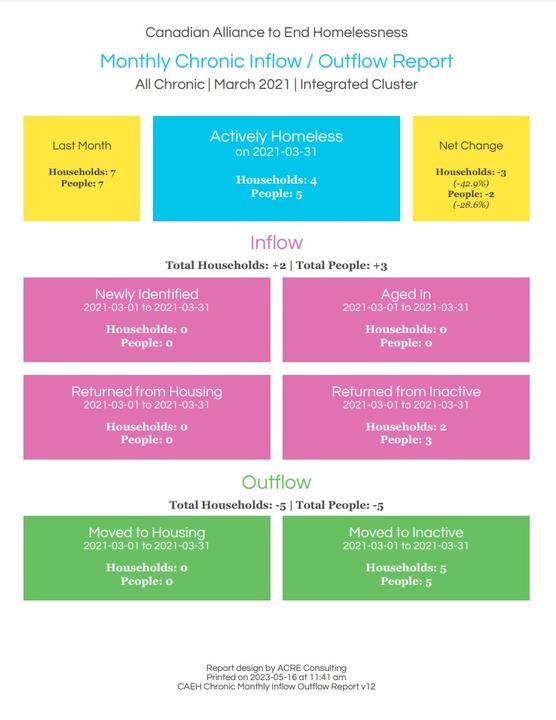
These reports are designed to help communities report on and analyze the monthly changes in their homeless population. There are three versions available: chronic, veteran, and all homeless. These reports display active, aged in, newly identified, returned from inactive, returned from housed, moved to inactive, and moved to housed, all for a single cluster for a specified month.
These reports are designed to help communities report on and analyze the monthly changes in their homeless population. There are three versions available: chronic, veteran, and all homeless. These rep…
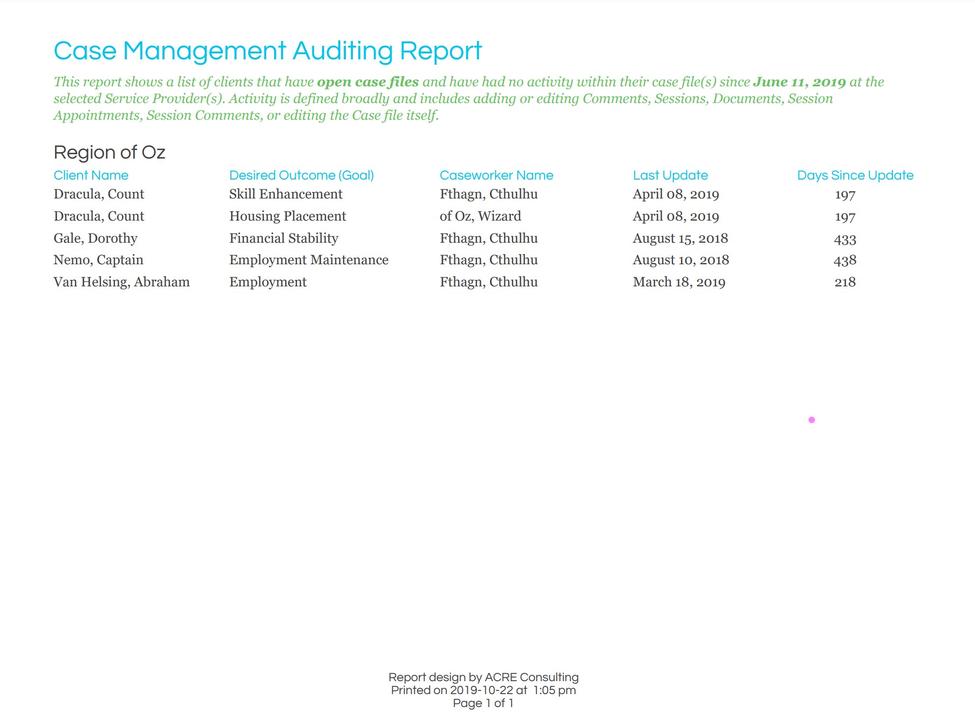
This report shows a list of clients that have open case files and have had no activity within their case file(s) since a specified date at the selected Service Provider(s). Activity is defined broadly and includes adding or editing Comments, Sessions, Documents, Session Appointments, Session Comments, or editing the Case file itself.
This report shows a list of clients that have open case files and have had no activity within their case file(s) since a specified date at the selected Service Provider(s). Activity is defined broadly…
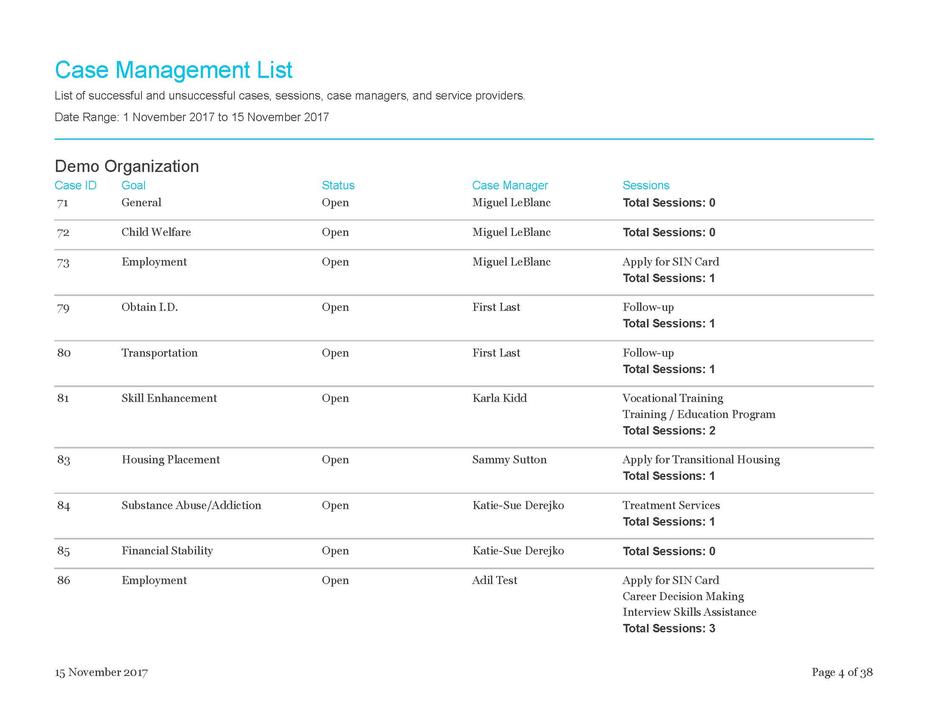
For the municipality’s CHPI reporting needs, they requested a report that will show: The number of Goals that were closed successfully versus unsuccessfully and what the goals were; How many of these goals had a Session created and what type of Session was it; Organized by case manager as well as Service Provider.
For the municipality’s CHPI reporting needs, they requested a report that will show: The number of Goals that were closed successfully versus unsuccessfully and what the goals were; How many of these …
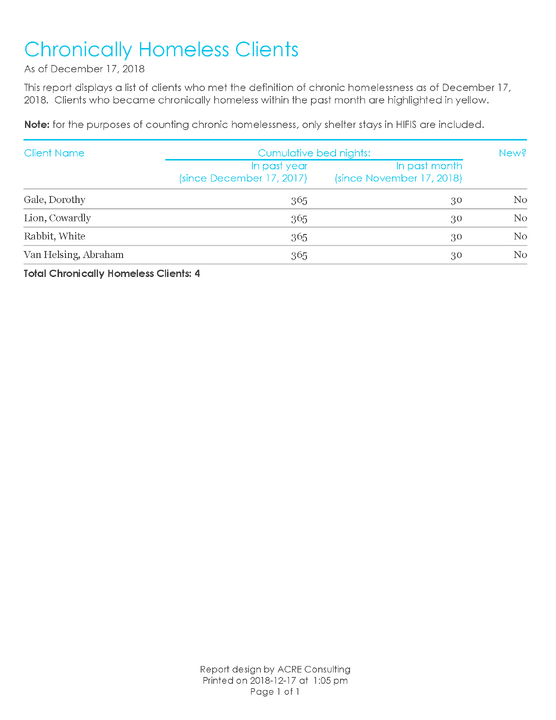
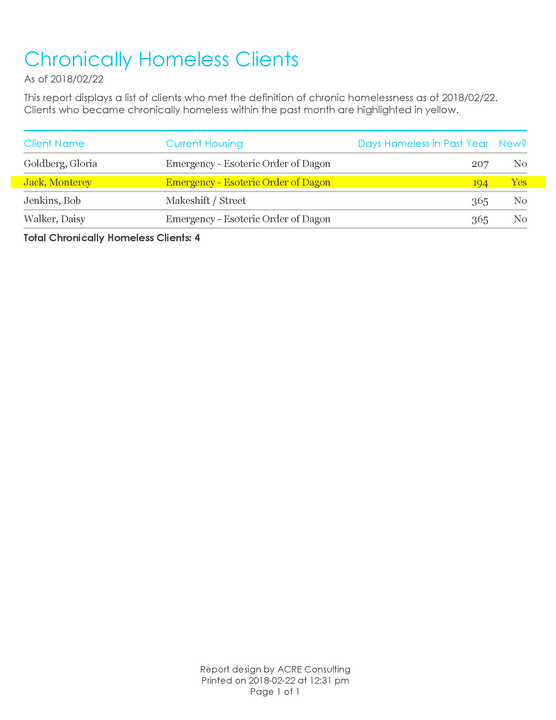
This report displays a list of all clients who are chronically homeless at the time that the report is generated, along with their total length of time homeless in the past year, and their current housing situation. Clients who are newly chronically homeless (became chronically homeless in the past year) are highlighted in yellow. Note that this report hard-codes a definition of homelessness; only particular housing types are included and it does not utilize the default rules nor does it look up a housing continuum.
This report displays a list of all clients who are chronically homeless at the time that the report is generated, along with their total length of time homeless in the past year, and their current hou…
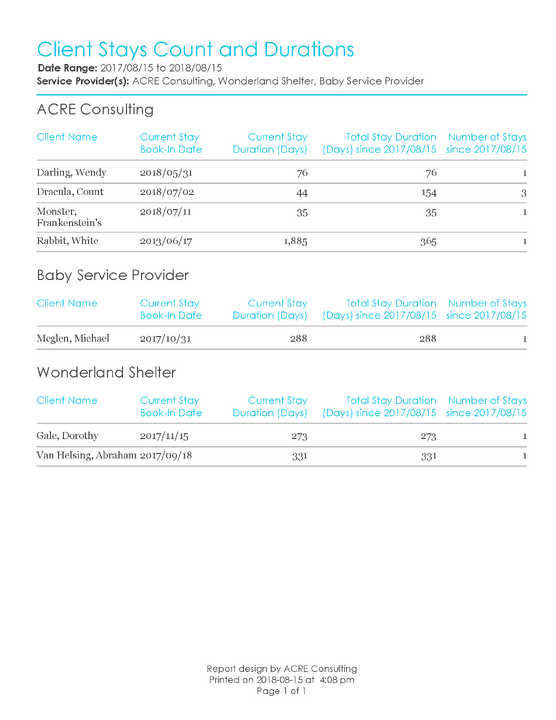
This report lists all clients currently booked in to selected Service Providers, and, for each client, lists their current stay duration, their total number of accumulated bed nights since a specified date, and the number of shelter book-ins since the specified date.
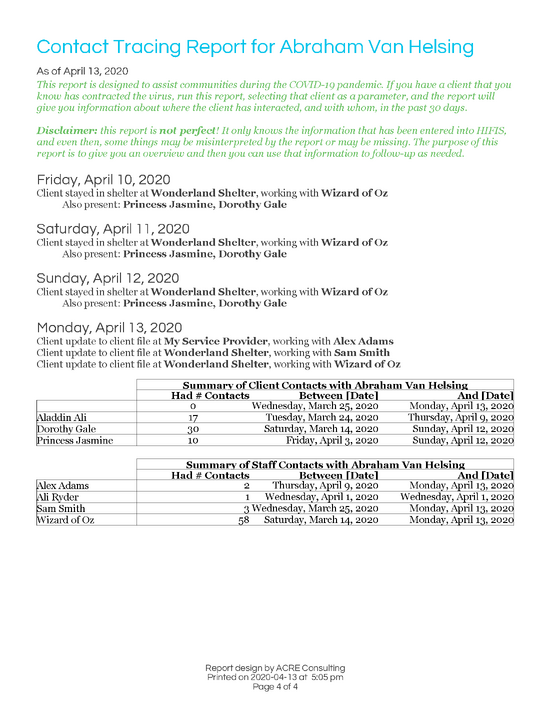
This report is designed to assist communities during the COVID-19 pandemic. If you have a client that you know has contracted the virus, run this report, selecting that client as a parameter, and the report will give you information about where the client has interacted, and with whom, in the past 30 days.
This report is designed to assist communities during the COVID-19 pandemic. If you have a client that you know has contracted the virus, run this report, selecting that client as a parameter, and the …
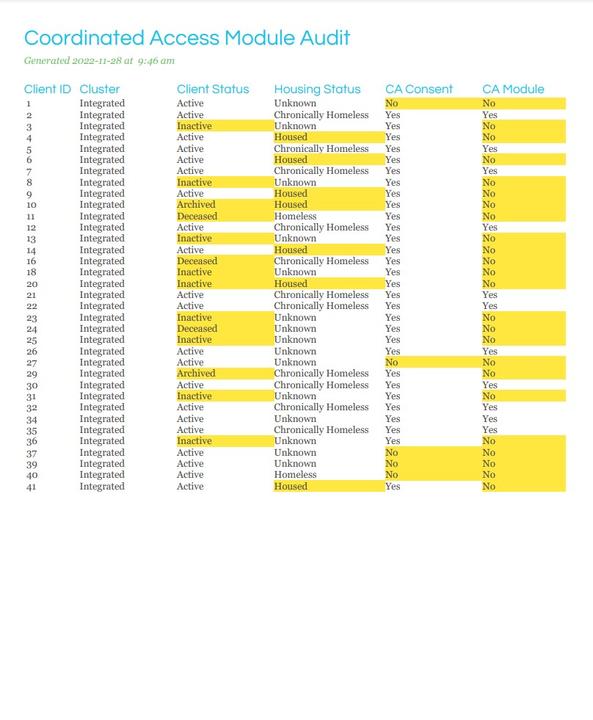
This simple report was comissioned by Lambton County to identify which clients were missing from their Coordinated Access module. It's intended to be exported to Excel and then filtered as needed, and just shows an anonymous list of clients along with their cluster, client status, housing status, Coordinated Access consent status, and whether or not they appear within the Coordinated Access module. Clients who would not appear are highlighted along with the reason they are not appearing.
This simple report was comissioned by Lambton County to identify which clients were missing from their Coordinated Access module. It's intended to be exported to Excel and then filtered as needed, and…
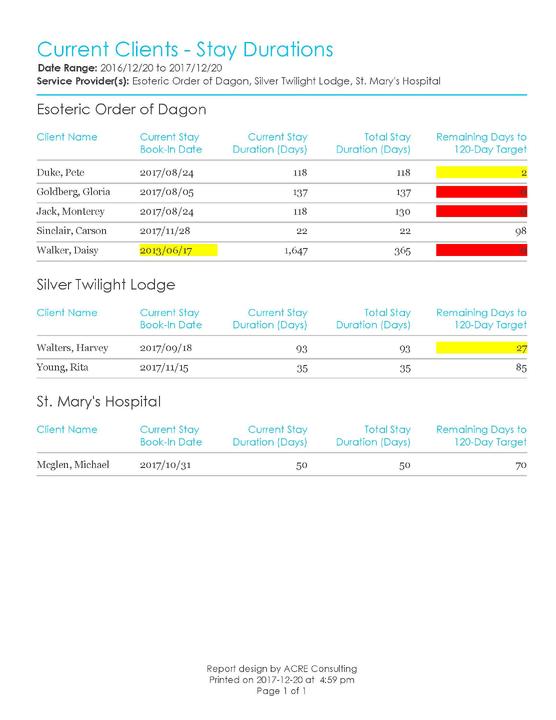

This report includes all Stays, belonging to the selected Service Provider, or at Motels and Referred by the selected Service Provider, that existed at 4:00am on the selected Date. This includes clients that have since booked out, and clients that are still booked in.
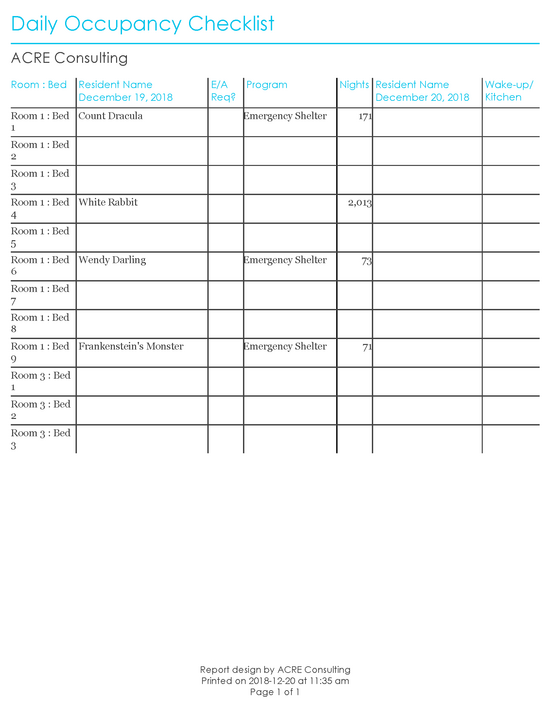
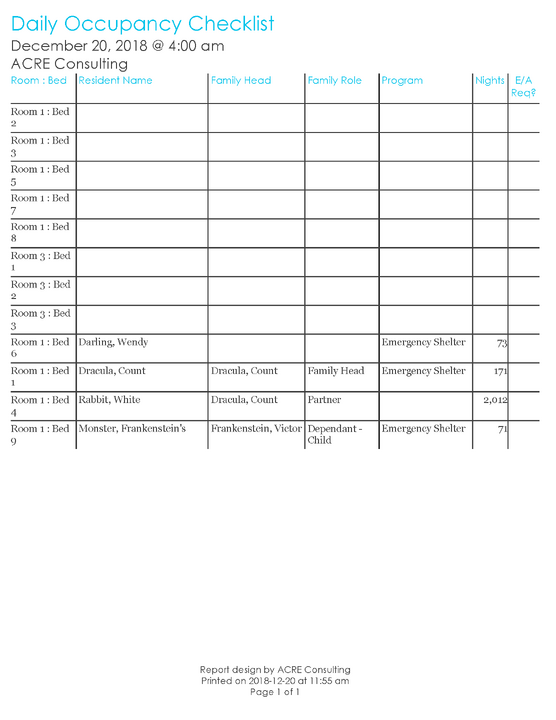
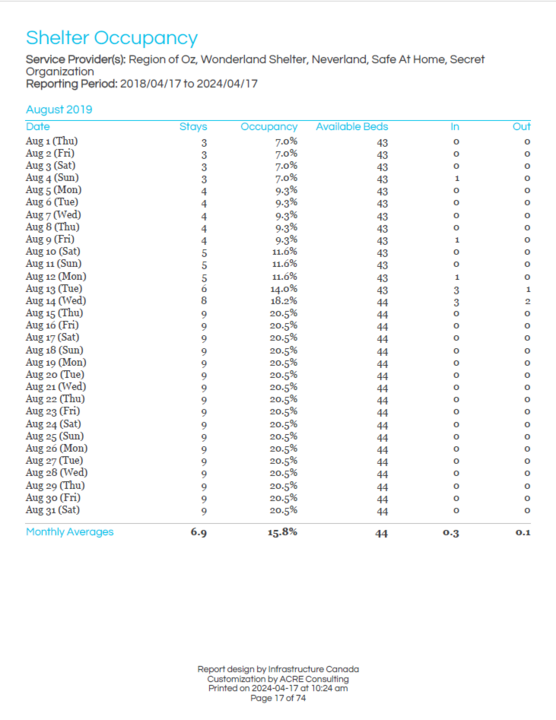
This report shows, for each day in the report range, the number of book ins and book outs and stays.
Note: this is a fixed version of the official HIFIS report.
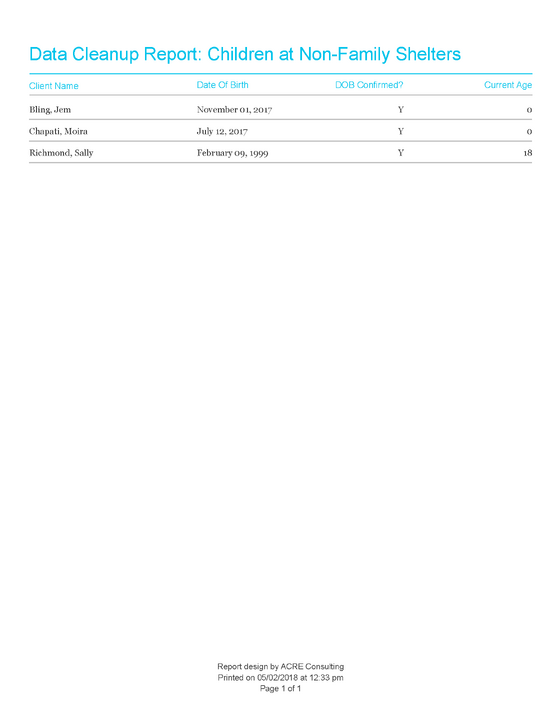
This is a data quality report that identifies children at specified shelters.
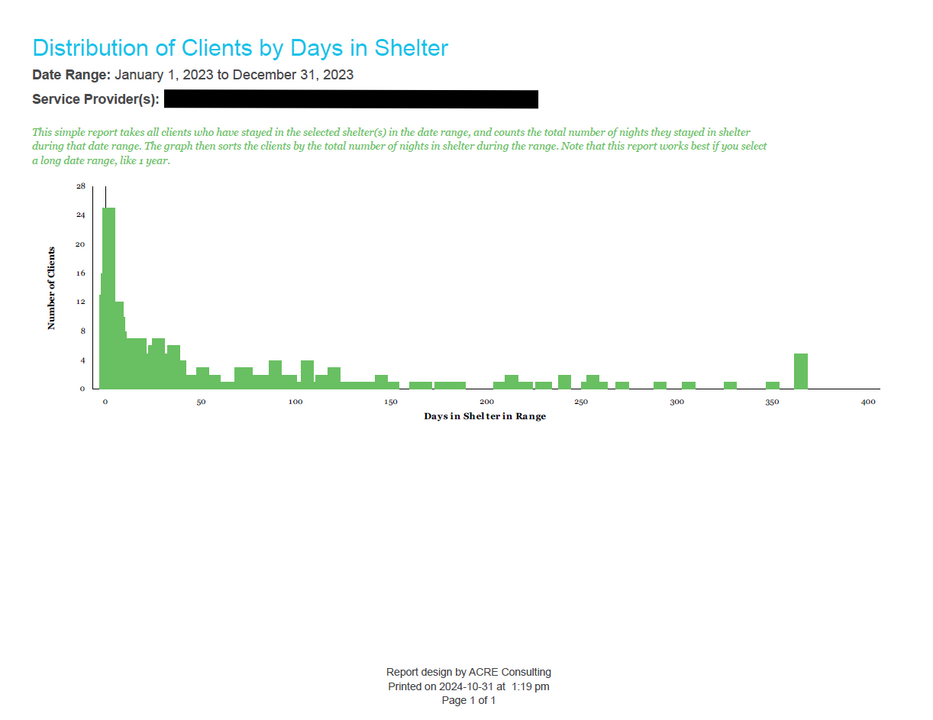
This simple report takes all clients who have stayed in the selected shelter(s) in the date range, and counts the total number of nights they stayed in shelter during that date range. The graph then sorts the clients by the total number of nights in shelter during the range. Note that this report works best if you select a long date range, like 1 year.
This report is a free tool that's a companion to my data wizardry presentation, You're Probably Lying About Homelessness, which you can watch on the webinars archive page.
This simple report takes all clients who have stayed in the selected shelter(s) in the date range, and counts the total number of nights they stayed in shelter during that date range. The graph then s…

This report displays a list of clients that have similar names, as specified by the report parameters. Note that it only matches exact strings, so for example "Jon" and "Jonathan" might return a match but "Jon" and "John" would not.

This report, commissioned by the City of Ottawa, aggregates data from the first shelter stay of clients in HIFIS 4. In other words, for each client, it looks up to see what was their first date of shelter admission, out of all the stays that have been recorded in HIFIS. Then it summarizes the total unique number of new shelter clients by month and by year, allowing you to track long-term shelter inflow data. There is no date parameters for this report; instead it automatically displays data for up to the past 5 years (if there is data going back that far).
This report, commissioned by the City of Ottawa, aggregates data from the first shelter stay of clients in HIFIS 4. In other words, for each client, it looks up to see what was their first date of she…
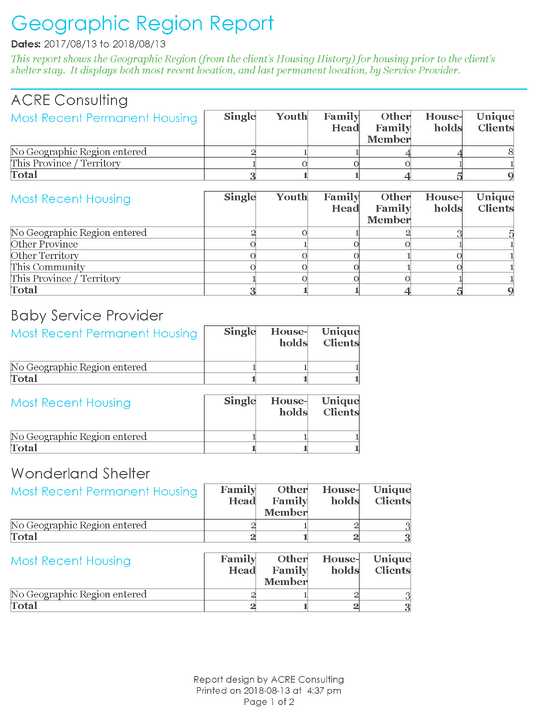
This report includes all Stays that began on or before the Report End Date and are still ongoing or ended on or after the Report Start Date, at any of the selected Service Provider(s). For these stays, it shows the Geographic Region from the Housing History of each client's previous housing and previous permanent housing.
This report includes all Stays that began on or before the Report End Date and are still ongoing or ended on or after the Report Start Date, at any of the selected Service Provider(s). For these stay…
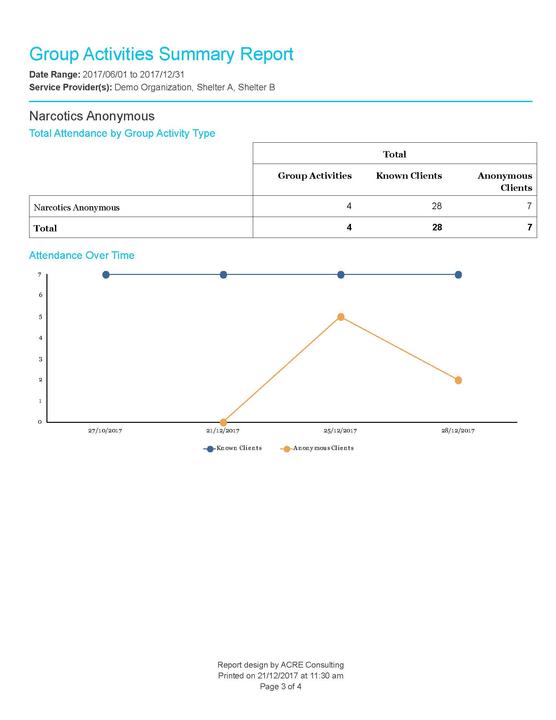
This report aggregates data for group activities in a specified date range at specified Service Providers. It sorts by type of group activity, and displays group activity attendance trends over time.
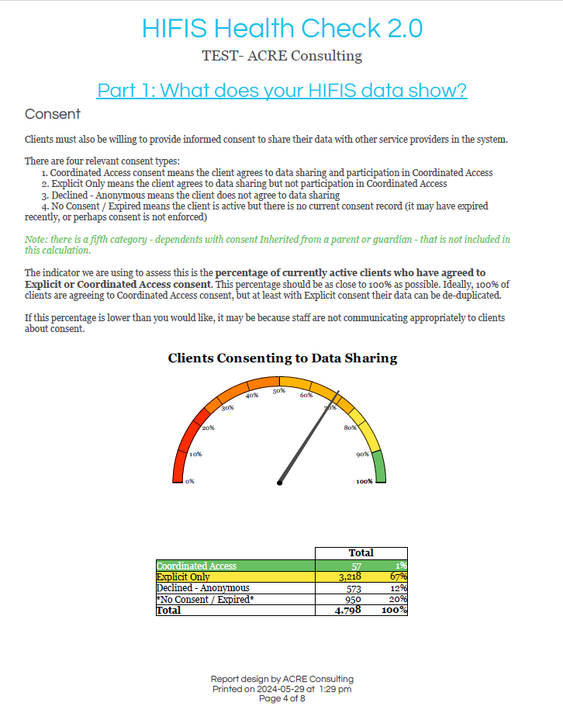
This newly updated HIFIS Health Check pulls data from HIFIS along 6 metrics:
Cluster integration
Consent
Potential duplicates
Unknown housing status
User logins
Inactive clients
Together, these metrics should serve to provide a high-level overview of how well your HIFIS data is able to support your Coordinated Access system and meet Reaching Home directives.
This newly updated HIFIS Health Check pulls data from HIFIS along 6 metrics:
Cluster integration
Consent
Potential duplicates
Unknown housing status
User logins
Inactive clients
Together, these metric…
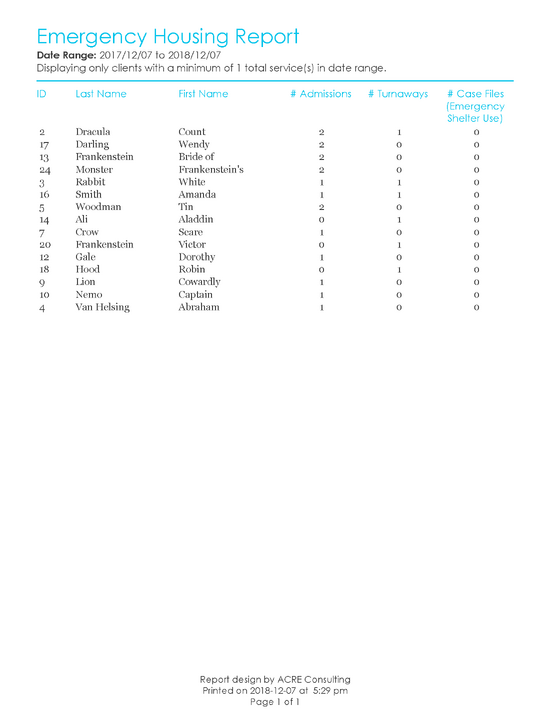
This report lists all clients that have had a minimum of X number of total services in a specified date range, where the user running the report specifies the value for X. Clients are sorted in order, with the highest service users first.
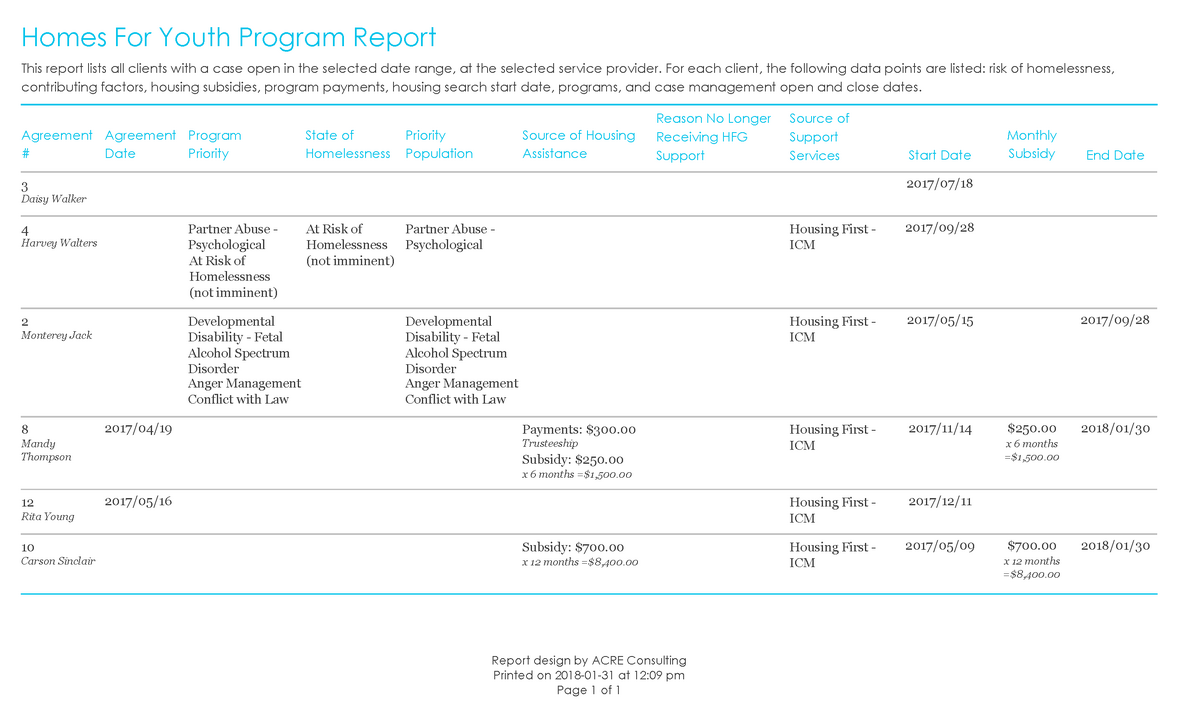
This report lists all clients with a case open in the selected date range, at the selected service provider. For each client, the following data points are listed: risk of homelessness, contributing factors, housing subsidies, program payments, housing search start date, programs, and case management open and close dates.
This report lists all clients with a case open in the selected date range, at the selected service provider. For each client, the following data points are listed: risk of homelessness, contributing f…

This simple run chart displays the number of monthly transitions from homelessness to housing recorded in HIFIS. Users can choose whether to include non-chronic, transitional, and unknown statuses before move-in. This report was inspired by the CAEH Performance Management Tracker.
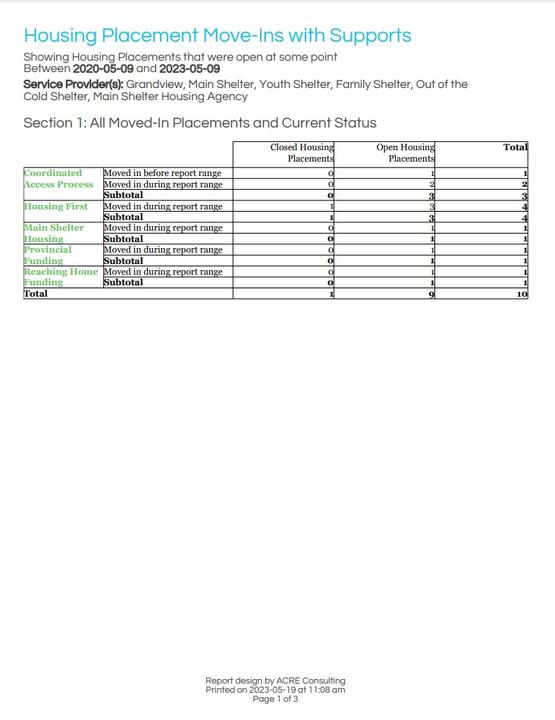
This report displays aggregated and detailed information about housing placements that have had a move-in during the report range. It displays Program information but does not have a Program parameter, so it should be usable by communities who are not making use of the Programs field.
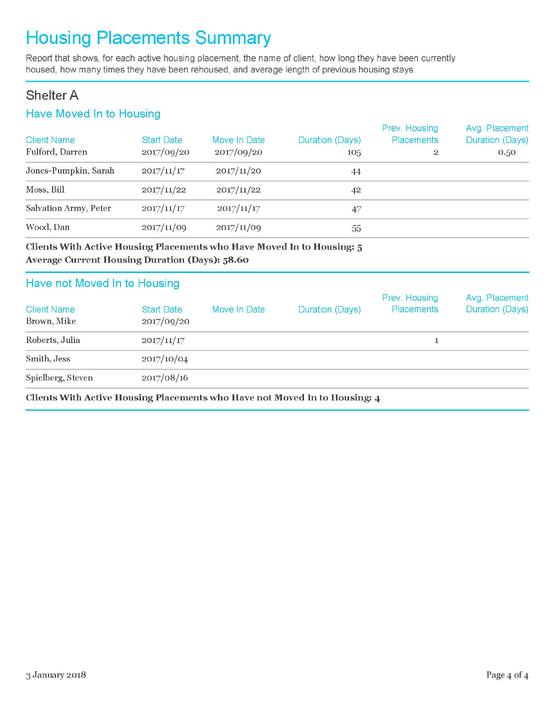
Report that shows, for each active housing placement, the name of client, how long they have been currently housed, how many times they have been rehoused, and average length of previous housing stays.
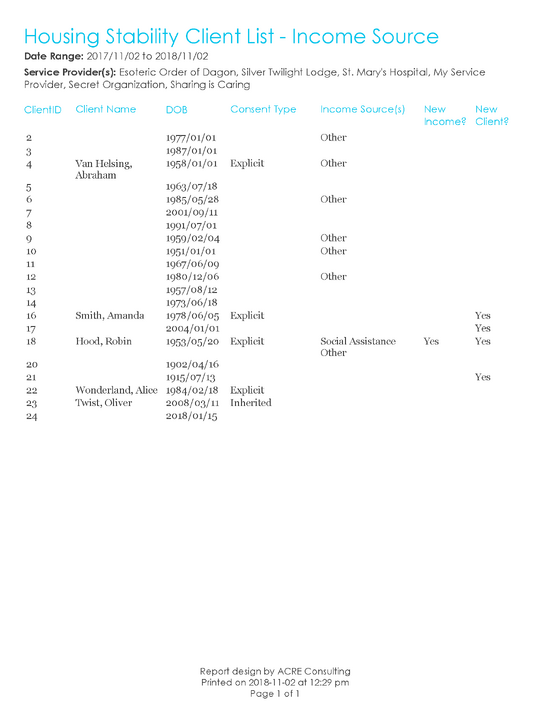
Lists all active clients during the selected date range receiving social assistance. Type of social assistance is listed for each client.
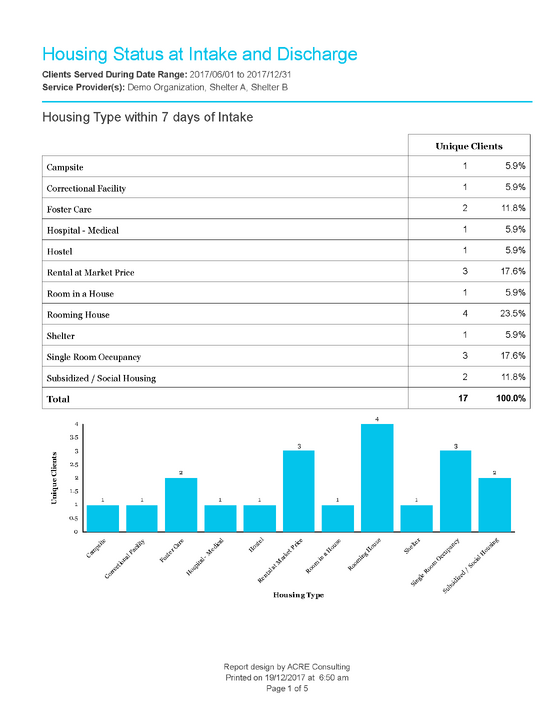
This report aggregates information for the housing of clients before and after entering shelters. It displays housing type prior to intake, reason for service, housing type after discharge, and reason for discharge.
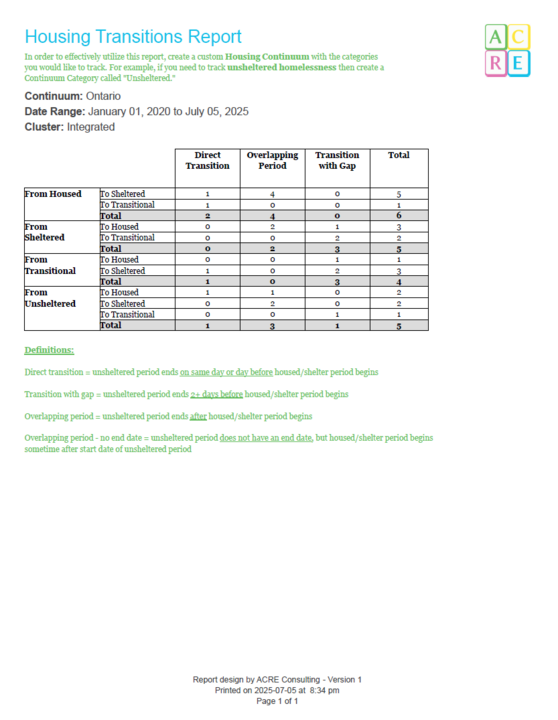
This report identifies and calculates housing transitions, overriding the Housing Status field in HIFIS and looking directly at Housing History and shelter Admissions. Housing transitions are defined as moving from one category in a Housing Continuum to another. If you wish to utilize custom housing categories, add a custom Housing Continuum, which you will be prompted to select when you run the report.
In part, this report is designed to assist Ontario communities required to report on transitions out of unsheltered homelessness.
This report identifies and calculates housing transitions, overriding the Housing Status field in HIFIS and looking directly at Housing History and shelter Admissions. Housing transitions are defined …
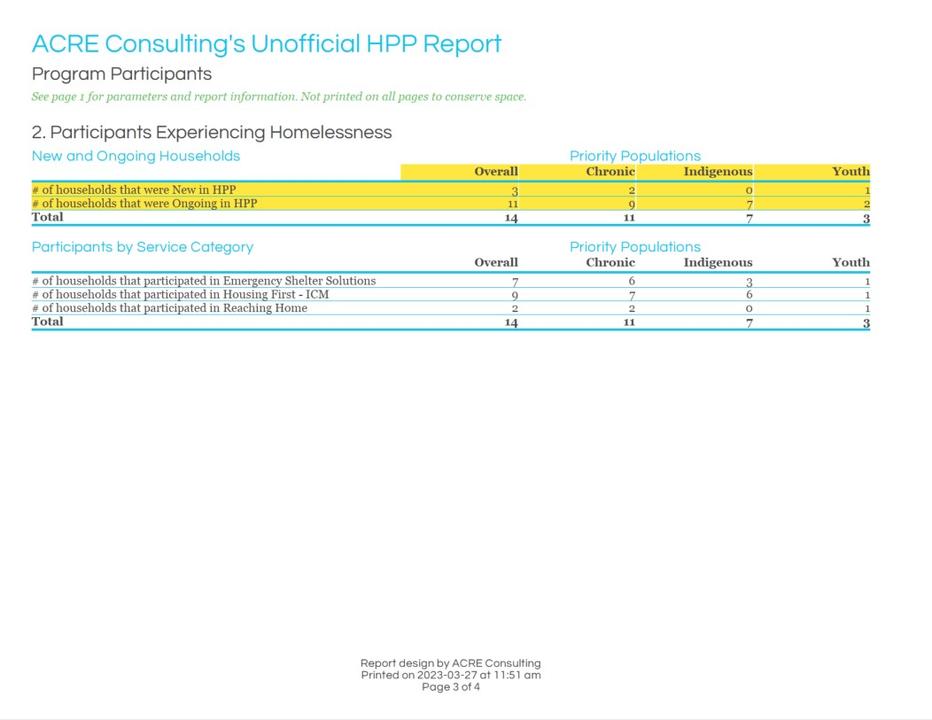
This report is intended to allow communities in Ontario who receive HPP funding to use HIFIS data to report out on the program participants section of the HPP reporting requirements, which encompass the majority of sections 1 and 2. Broadly speaking, the report summarizes data about which households received services associated with which Programs. It also determines the first time the household received a service like it, and from that determines whether the client was homeless or at risk of homelessness at the time, and also whether that means the client was new to HPP or a returning household.
This is an unofficial report and is not endorsed by the Ontario MMAH.
This report is intended to allow communities in Ontario who receive HPP funding to use HIFIS data to report out on the program participants section of the HPP reporting requirements, which encompass t…

This report is intended to allow communities in Ontario who receive HPP funding to use HIFIS data to report on housing attainment, loss, and retention. Broadly speaking, the report summarizes data about households that had a move-in or retained housing for 12 months or who became homeless, filtered by date range, service providers, programs, and service types.
This is an unofficial report and is not endorsed by the Ontario MMAH.
This report is intended to allow communities in Ontario who receive HPP funding to use HIFIS data to report on housing attainment, loss, and retention. Broadly speaking, the report summarizes data abo…
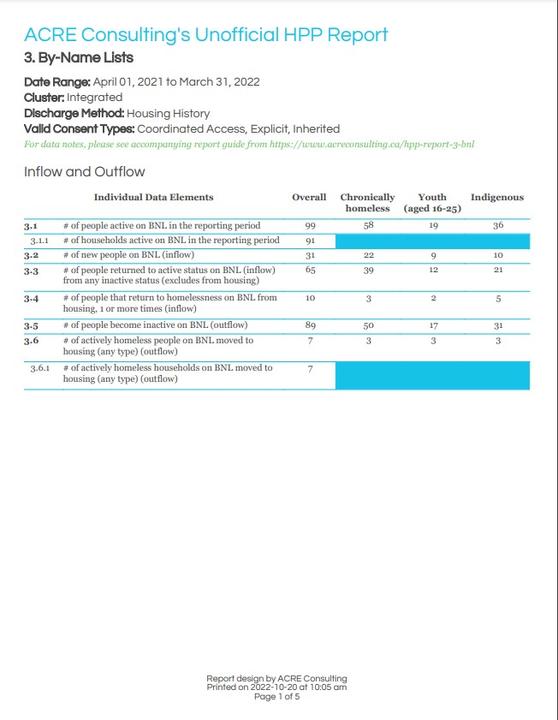
This report is intended to allow Ontario communities who receive HPP funding to use HIFIS data to report out on the By-Name List section of the HPP reporting requirements. Broadly, it reports on the aggregated inflow and outflow to and from your By-Name List (BNL) and breaks down these numbers into the priority population groups.
This is an unofficial report and is not endorsed by the Ontario MMAH.
This report is intended to allow Ontario communities who receive HPP funding to use HIFIS data to report out on the By-Name List section of the HPP reporting requirements. Broadly, it reports on the a…
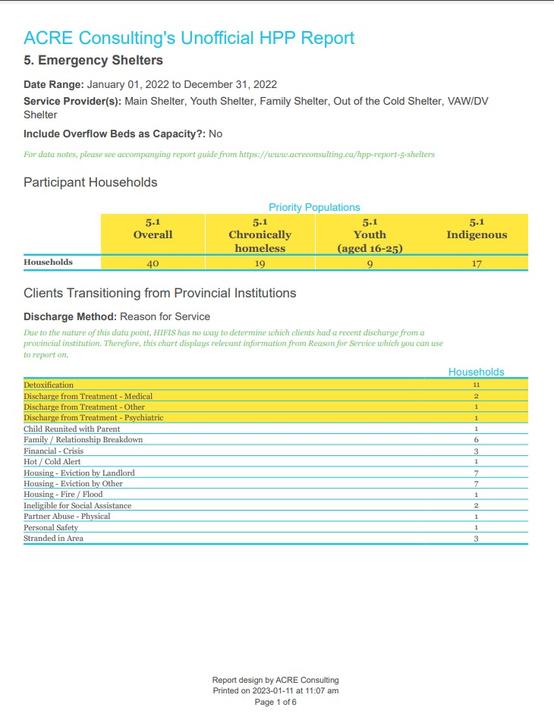
This report is intended to allow communities in Ontario who receive HPP funding to use HIFIS data to report out on the Emergency Shelters section of the HPP reporting requirements. Broadly, it reports on emergency shelter capacity and usage, broken down into priority population groups.
This is an unofficial report and is not endorsed by the Ontario MMAH.
This report is intended to allow communities in Ontario who receive HPP funding to use HIFIS data to report out on the Emergency Shelters section of the HPP reporting requirements. Broadly, it reports…
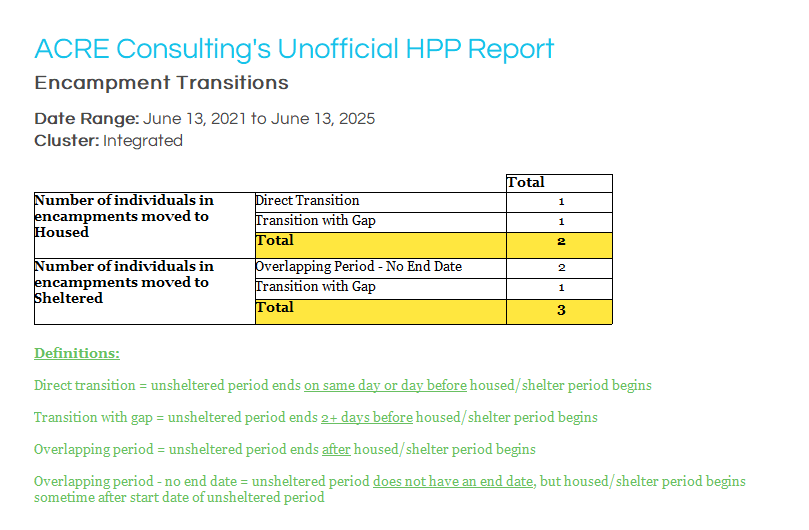
This report is intended to allow communities in Ontario who receive HPP funding to use HIFIS data to report on encampment transitions. This report shows the number of clients who moved from encampments to other housing types.
This is an unofficial report and is not endorsed by the Ontario MMAH.
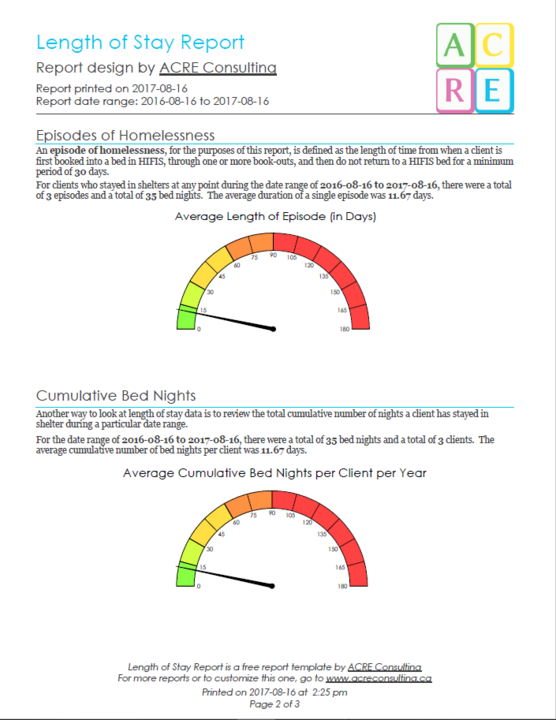

This report, developed for the Brandon Neighbourhood Renewal Corporation, was intended to identify which indigenous women were at the highest risk for becoming missing or murdered. Watch their presentation at #CAEH24. Note that all risk factors are based on responses in the VI-SPDAT.
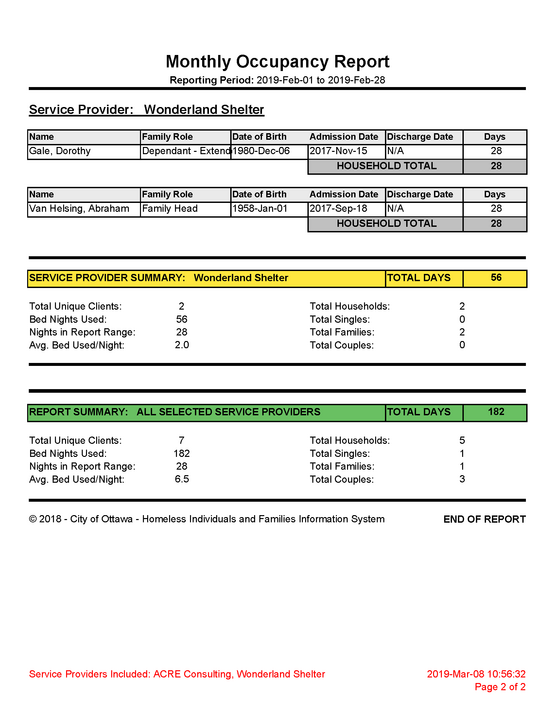
This report was developed for the City of Ottawa to show a list of all clients that had stayed in selected shelter(s) during a specified date range. The report lists clients, grouped by household, and displays each client's family role for that household, along with each family member's date of birth, admission date, and discharge date.
This report was developed for the City of Ottawa to show a list of all clients that had stayed in selected shelter(s) during a specified date range. The report lists clients, grouped by household, and…
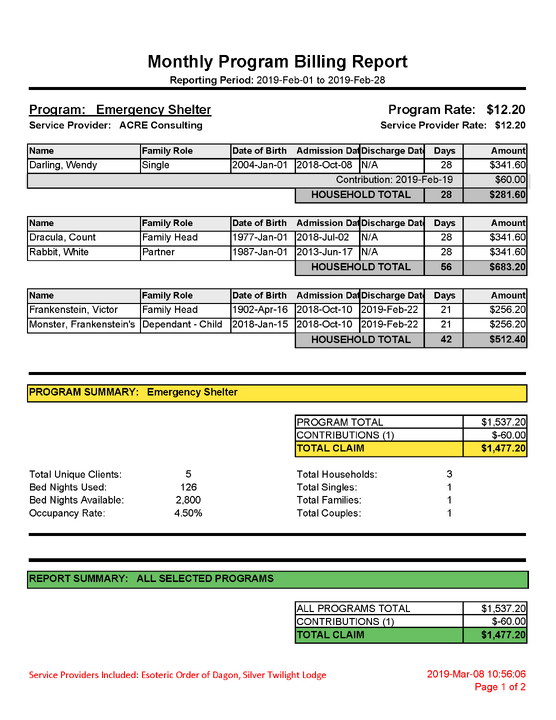
This report was developed for the City of Ottawa to show a list of all clients that had stayed in selected shelter(s) during a specified date range. The report lists clients, grouped by household, and displays each client's family role for that household, along with each family member's date of birth, admission date, and discharge date.
This report was developed for the City of Ottawa to show a list of all clients that had stayed in selected shelter(s) during a specified date range. The report lists clients, grouped by household, and…

This report examines the number of open cases to determine current caseload. It is a tool for communities which are delivering case management services to people experiencing homelessness, to examine whether caseloads are balanced across case managers, and whether overall caseloads meet established standards.
This report examines the number of open cases to determine current caseload. It is a tool for communities which are delivering case management services to people experiencing homelessness, to examine …

This report was commissioned by the City of Brantford to act as their prioritization list. It builds on the Coordinated Access module in HIFIS 4.0.59, and includes some additional features. Some of these modifications include: Contributing Factors, trimorbidity, current Case goal and caseworker, Family size, approaching inactivity, and presence on a Waiting List.
This report was commissioned by the City of Brantford to act as their prioritization list. It builds on the Coordinated Access module in HIFIS 4.0.59, and includes some additional features. Some of th…
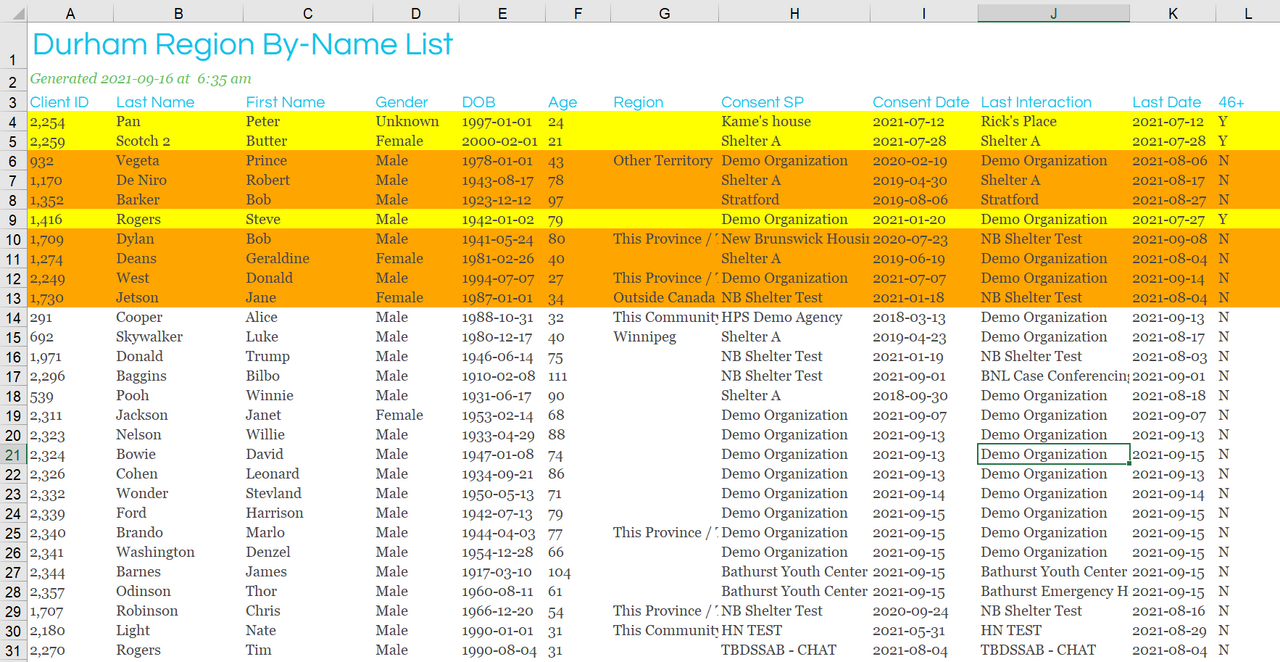
This report was commissioned by the Region of Durham to act as their prioritization list. It builds on the Coordinated Access module in HIFIS 4.0.59, and includes some additional features. Some of these modifications include: date and location consent was signed at, approaching inactivity, date Housing History was updated, trimorbidity, trauma/abuse, family reunification, and a unique prioritization formula.
This report was commissioned by the Region of Durham to act as their prioritization list. It builds on the Coordinated Access module in HIFIS 4.0.59, and includes some additional features. Some of the…
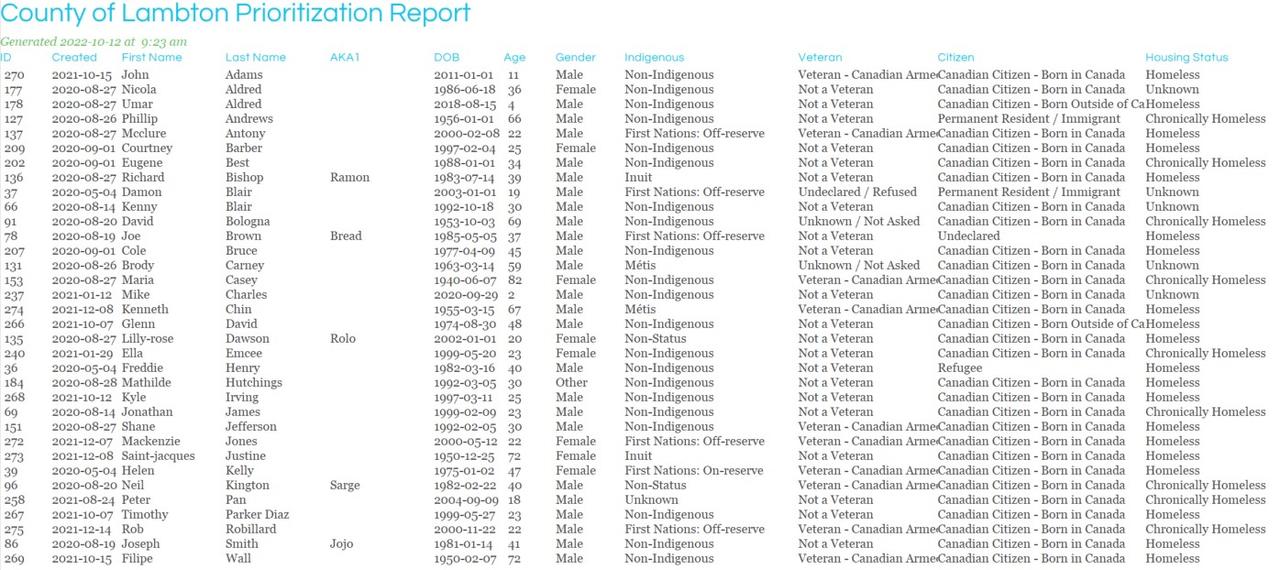
This report was commissioned by the County of Lambton to act as their prioritization list. It builds on the Coordinated Access module in HIFIS 4.0.59, and includes some additional features. Some of these modifications include: bypassing the default calculation of chronicity, pulling out some fields from the VI-SPDAT, and using Reason for Service data to determine institutional discharges.
This report was commissioned by the County of Lambton to act as their prioritization list. It builds on the Coordinated Access module in HIFIS 4.0.59, and includes some additional features. Some of th…
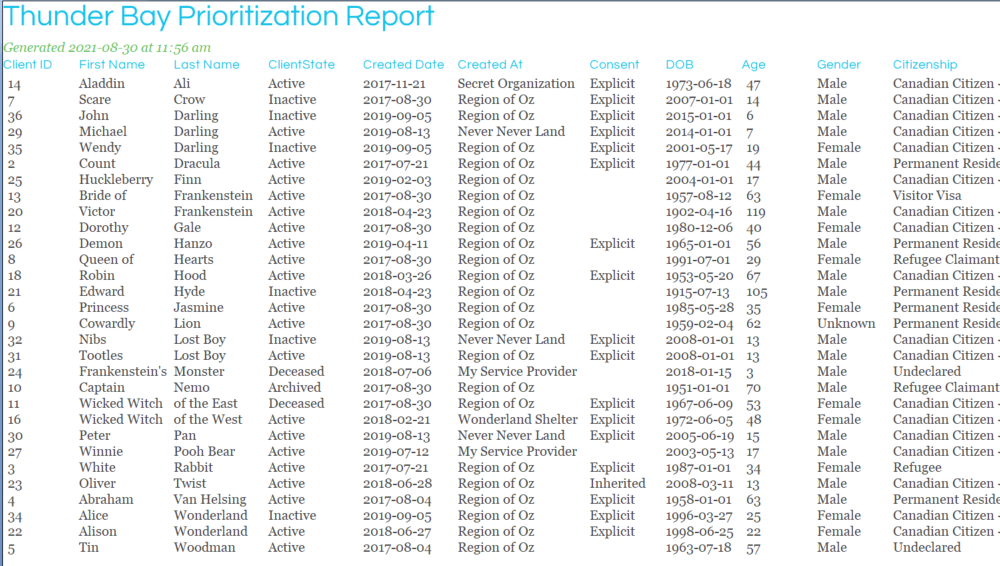
- Contributing Factors,
- Turnaways,
- client creation date,
- most recent service provider interaction,
- consent type, and
- most recent city.

This is Waterloo's prioritization list, which pulls data from a Waiting List called PATHS, and includes the following data: name, household type, household size, gender, age, status (Waiting List Priority), caseworker, VI-SPDAT score, SPDAT score, date added to waiting list, date removed from waiting list, days on waiting list, chronic status, trimorbidity (derived from VI-SPDAT), risk (derived from VI-SPDAT), critical safety (derived from Watch Concern), previous shelter, CHAC (presence on another Waiting List), housing preferences (from Custom Table).
This is Waterloo's prioritization list, which pulls data from a Waiting List called PATHS, and includes the following data: name, household type, household size, gender, age, status (Waiting List Prio…
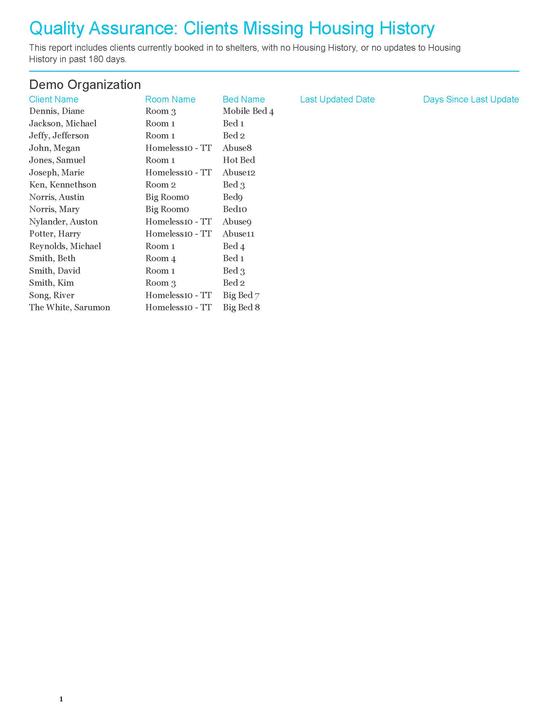
This report includes clients currently booked in to shelters, with no housing history record, or no updates to housing history in the past 180 days.
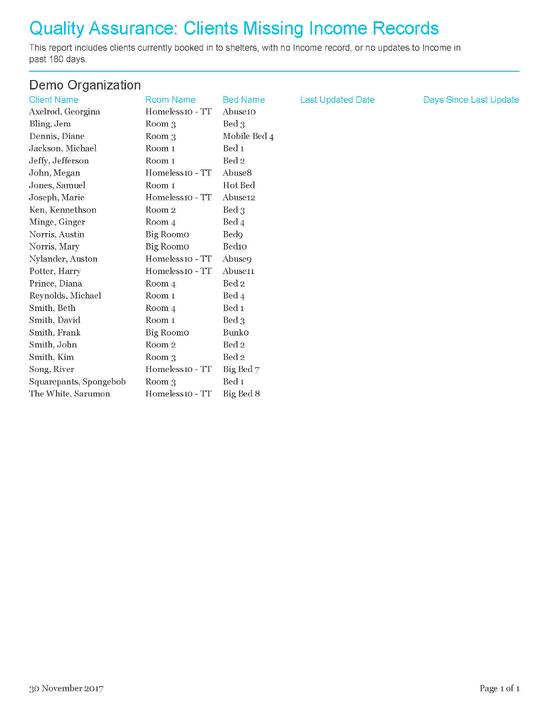
This report includes clients currently booked in to shelters, with no income record, or no updates to income in the past 180 days.
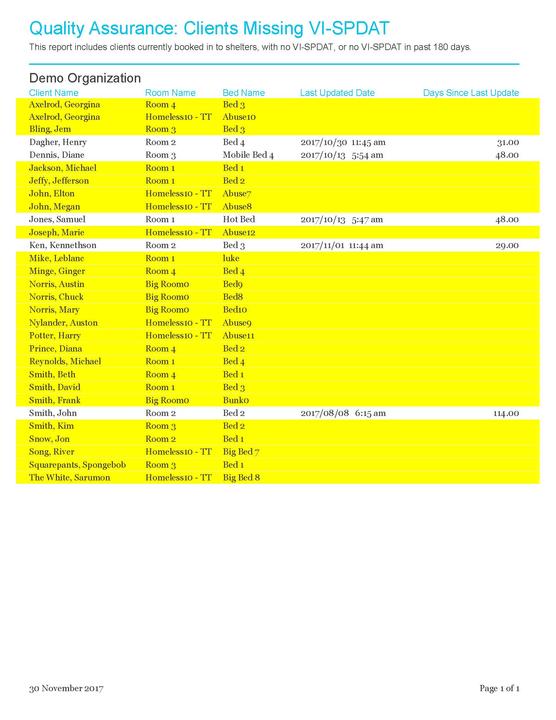
This report includes clients currently booked in to shelters, with no income record, or no updates to income in the past 180 days.
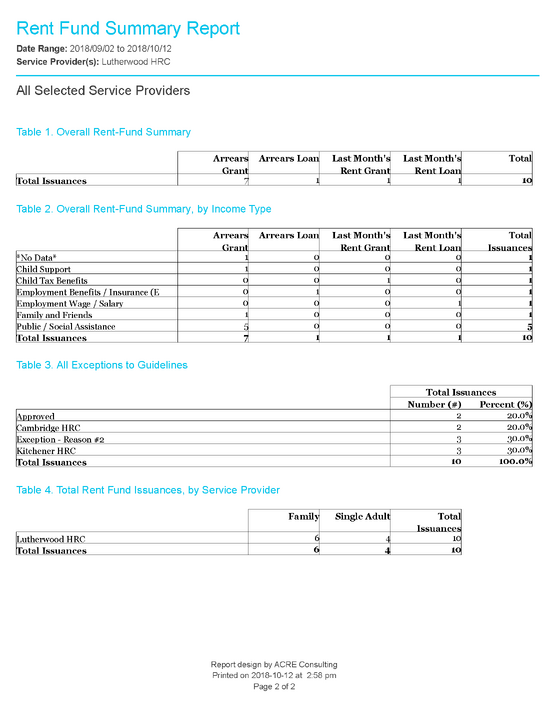
This report summarizes Housing Subsidies, by Reason for Service, Income, Program, Service Provider, and Family status.
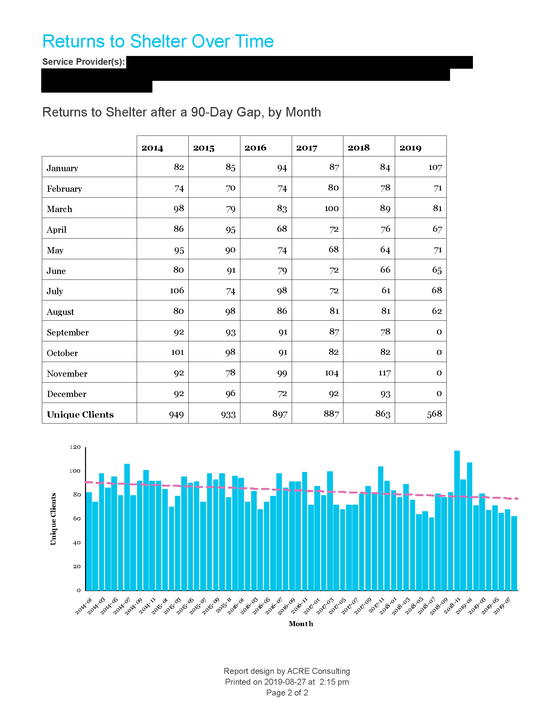
This report aggregates data from the shelter stays of returning clients in HIFIS 4. In other words, when a client has previously stayed in a shelter, then after a period of at least 90 days not in shelter, has a new shelter intake, the date of their new shelter intake is counted. Then it summarizes the total number of returning shelter clients by month and by year, allowing you to track long-term shelter inflow data.
This report aggregates data from the shelter stays of returning clients in HIFIS 4. In other words, when a client has previously stayed in a shelter, then after a period of at least 90 days not in she…
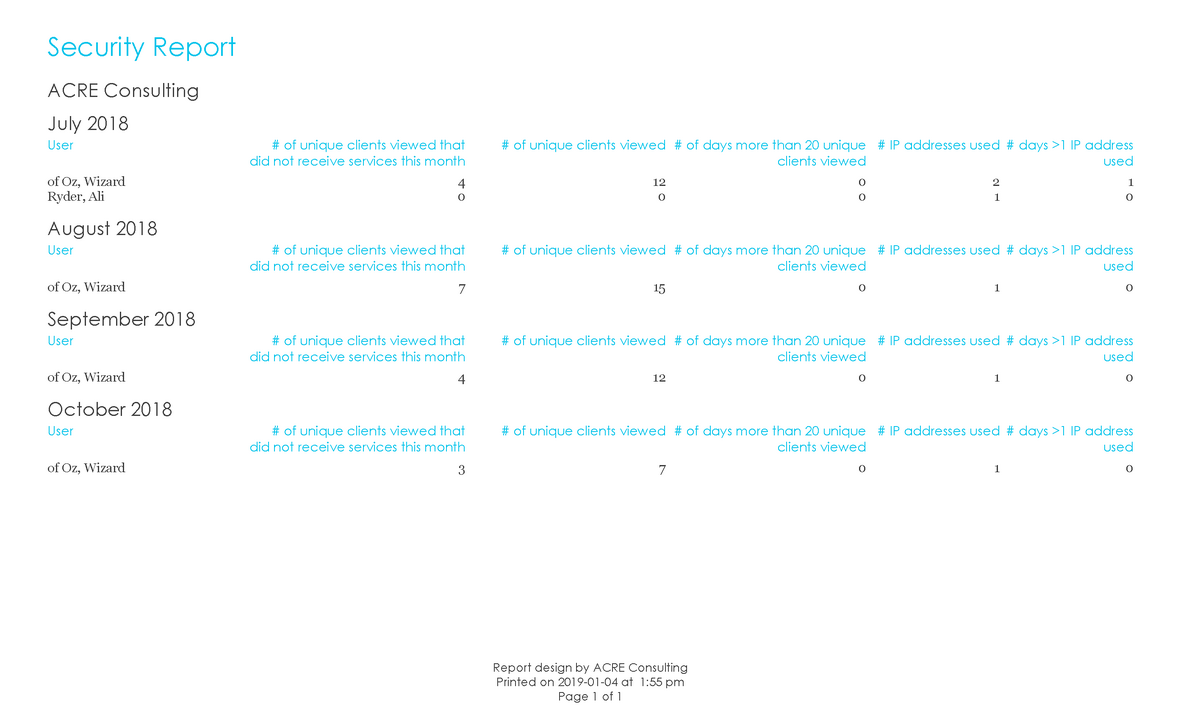
This report includes all actions stored in the audit log performed by Users logged in at the selected Service Provider within a specified Date Range. For each action, several data points are reviewed: IP address and Client ID. Then, for each User, several data points are displayed regarding their actions in a given month.
This report includes all actions stored in the audit log performed by Users logged in at the selected Service Provider within a specified Date Range. For each action, several data points are reviewed:…
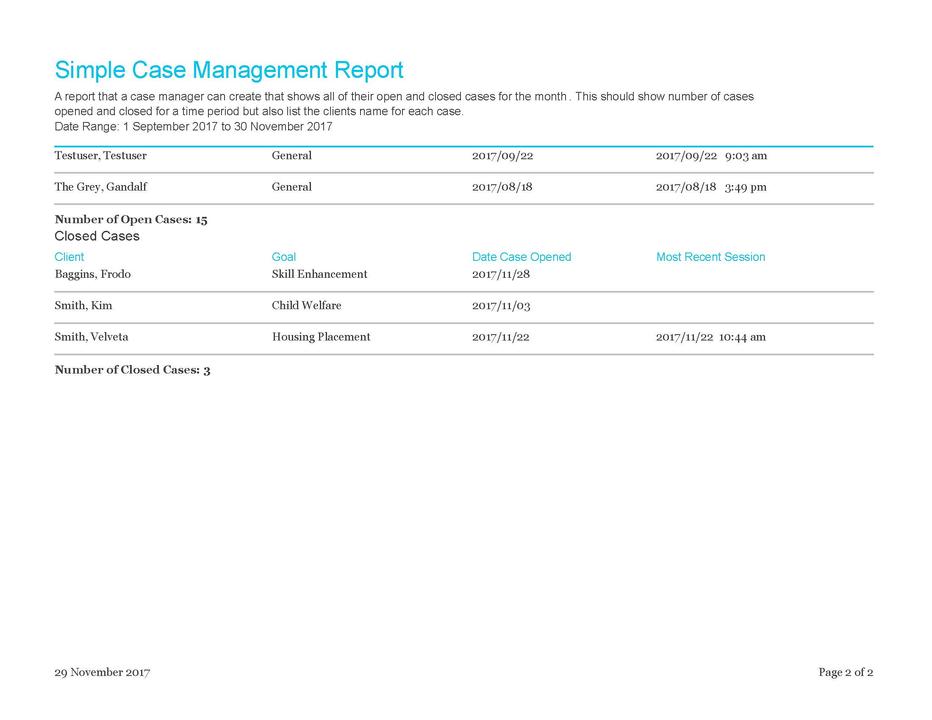
A report that a case manager can create that shows all of their open and closed cases for the month . This should show number of cases opened and closed for a time period but also list the client's name for each case.
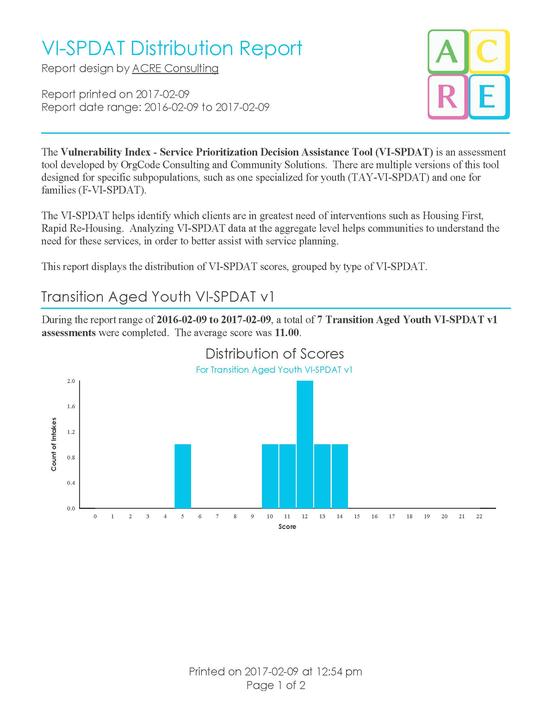
This report displays the distribution of VI-SPDAT scores, grouped by type of VI-SPDAT.
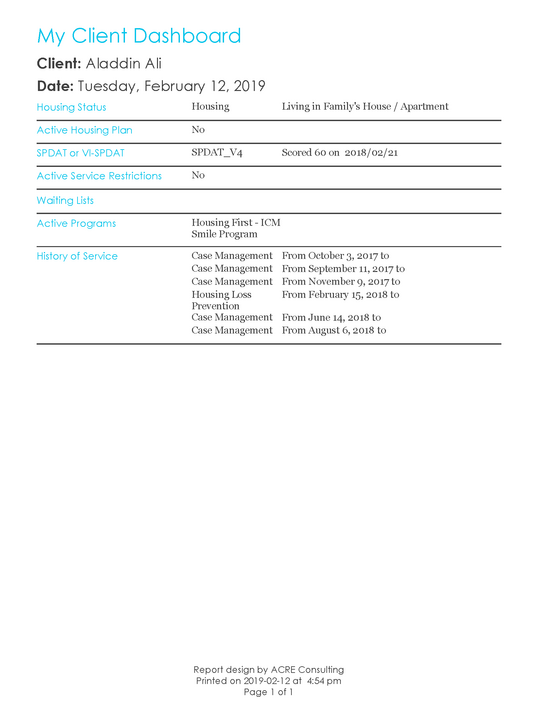
This report shows, for a single client, their housing status, whether they have a housing plan (custom table), their recent VI-SPDAT/SPDAT data, whether they have acitve service restrictions, whether they are on any waiting lists, what programs they are actively enrolled in, and their history of service.
This report shows, for a single client, their housing status, whether they have a housing plan (custom table), their recent VI-SPDAT/SPDAT data, whether they have acitve service restrictions, whether …
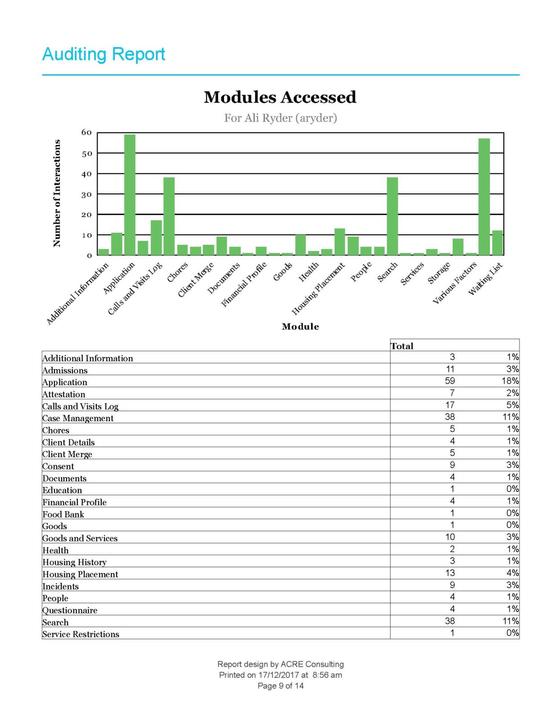
- A summary of the user’s rights templates and what Service Providers they have access to
- A list of all the user’s activities in a specified time period
- A summary of the modules the user accessed, and how many times
- A summary of the clients the user accessed, and how frequently
- A summary of the user’s activities over time, per weekday, and per hour
- A summary of the user’s rights templates and what Service Providers they have access to
- A lis…
